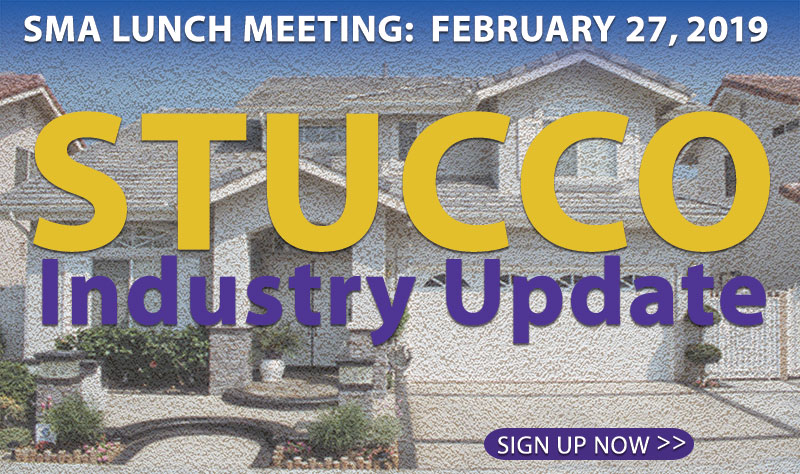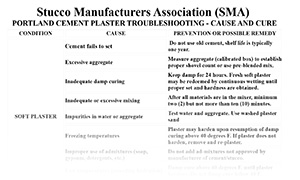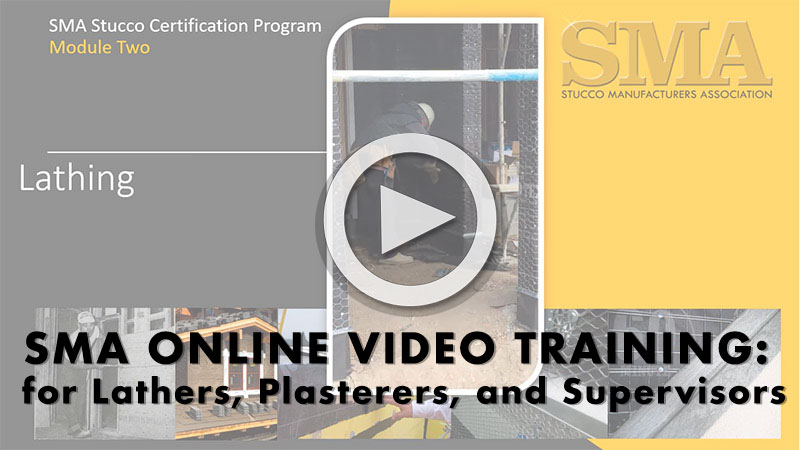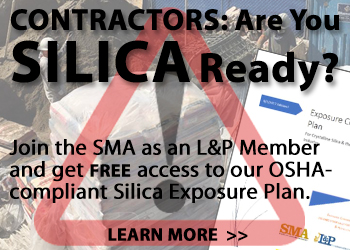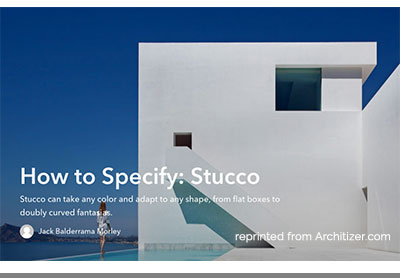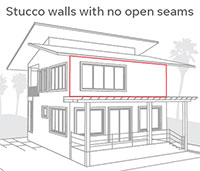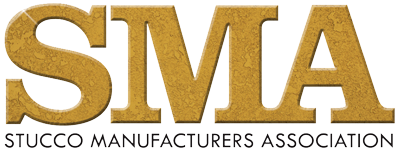Newsletter
Winter 2023 eNews
The SMA’s Winter 2023 newsletter covers promotional efforts for the stucco industry at the NAHB Internal Builders Show.. We go in depth on cement plaster on masonry walls with a history , best practices, tips and options for making an outside corner. We include information about the upcoming Membership meeting on March 28 and information about our featured speaker. There is quiz on plastering and news of the passing of industry icon.
Fall 2022 eNews
The SMA has launched a new format and style of newsletter. We call it Tech Talk. This is because technical issues are a prime concern for all in the stucco industry. This issue focuses on windows in stucco clad walls. SMA provides some basic guidelines on flashing and what the code really says about flashing. Since we are a national association for lath and plaster, we will always try to cover the regional issues as well.
Spring 2022 eNews
FROM THE SMA EXECUTIVE DIRECTOR

Mark Fowler, SMA Executive Director
2022 SMA Board of Directors
The last few years have been tough, the SMA postponed board elections, stopped in-person meetings and canceled the annual golf tournament. The SMA is about to re-launch in-person meetings and working to making them virtual so out of state members can join in remotely. The SMA Board of Directors are from all over the United States: your current SMA Board is:
Dale Nehls, President, Quikrete
Kevin Wensel, Vice President, Omega Products
Tom Susko, Treasurer, Home Plaster Inc
Herman Guevara, Plastic Components
Dennis Deppner, Master Wall, Inc.
Gary Goodwin, K-Lath
Kevin Ordiales, Ashgrove Cement
DJ Farley, Weatherization Partners
Chip Blome, L&W Supply
The SMA board meets quarterly to discuss the industry and provide guidance to projects and direction taken by the SMA. This includes past accomplishments such as the only Silica exposure plan dedicated to plastering and adhered stone work with “Industry Objective “data on Action Levels and PEL. The six modules of on-line training for lath and plaster, including a supervisor’s class for plastering. The Stucco Market Study that uses US Census bureau data and ties it directly to the plastering industry. Tech Times Bulletins on recognized industry practices for lathing and plastering.
SMA HAPPENINGS NOW: The SMA routinely works with a variety of entities in the stucco industry and on occasion we get out to live events. The SMA recently was in Denver at Smalley and Co to do a training class on SMA Modules and certification. The even was well attended by local stucco contractors.
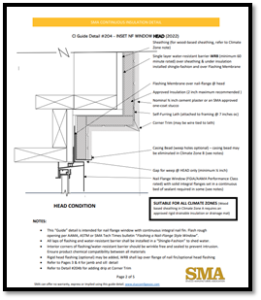
SMA UPCOMING: The SMA is working on a series of stucco details and a design guide. With three live webinars completed for Architects, the SMA has now become the leading source of information regarding lath and plaster product selection and design concerns. The request for details on stucco regarding Continuous Insulation, Rain Screen, over CMU and if the water-resistive barrier can be placed over the plastic insulation is immense. The SMA is responding with the largest library of details known in the industry. This includes tips, caveats and recommendations regarding Climate Zone. For example, Continuous Insulation Stucco for an Inset window (see graphic) is 6 pages covering an overview, head, jamb, sill, drip edge and options for stucco abutting the window frame. Details are reviewed by experts in building science, architecture and defect litigation. They are generic and considered “Guide” details to help designers create their own details that lath & plastering contractors will find constructable and cost effective.
CONTRACTOR ALERT
SMA Contractors – the new Silica Exposure Plan is available. All contractors are required by OSHA to have a Plan, perform air monitoring and have the Plan reviewed annually. The SMA does the air testing for various tasks (specific to lath/plastering and adhered masonry). You should print the plan and have that current plan available to workers, this can be inserted into your safety binder. The other requirement is to have an assigned Competent Person. The SMA provides a free on-line class for your Competent Person. There is a 25-question test to verify comprehension. A pictureID card can be issued upon passing the class upon request. There is also a tool box talk sheet that foreman can use to ensure you cover what OSHA requires be taught to your workers. The tool box form is also available in Spanish. Contact Marlene@Stuccomfgassoc.com
ASTM C1063
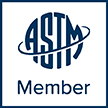
The SMA is frequently asked about ASTM changes to keep up to date with regard to installing lath and plaster. ASTM C 1063 is a nationally recognized standard used for the installation of lath for Portland cement plaster. It is a living standard that changes and evolves through committee action. Historically, the standard change very little. However, recently those changes have been more often and impactful.
The SMA is an organizational member of ASTM and compared the 2006 version to the 2020 version of C1063. The standards bare little resemblance to each other. The most notable changes are below. The next SMA newsletter will cover changes on C 926 (the application of cement plaster).
Most changes are related to shifting sections and edits or grammatical changes. Often new references need to be added to connect to related ASTMS. The SMA includes the section number for reference and a brief recap of the new language. SMA commentary is added if an explanation or caveat is advised.
The SMA provides this as a service to members, for exact language refer to ASTM C 1063-20.
2020 ASTM C1063-20
SUSPENDED CEILINGS: The older ASTM version had a large section on the rules for design and installation suspended cold rolled channels with various tables related to lath and plaster suspended ceilings. That language was removed and made as an ANNEX. It is still mandatory ASTM Language.
CONTROL/EXPANSION JOINTS: The most notable change related to these joints is adding a definition for each.
Section 3.2.2 now defines a control joint as a joint that accommodates movement of plaster shrinkage and curing along predetermined, usually straight lines.
Section 3.2.3 Expansion joints are defined as a joint that accommodates movement beyond plaster shrinkage and curing. There is now a NOTE or reference to design considerations shall see ASTM C926 A2.3.1.2. This C926 section states both control and expansion joints, including the integration with the water-resistive barrier shall be graphically depicted in the contract documents.
SMA Commentary: the SMA feels the new definition helps provide some guidance. In addition, adding the requirement to “graphically” depict joints on drawings (contract documents) will help contractors. The SMA agrees it is the architect who should decide where and how many control joints are needed. Including not requiring any control joints as they have the right per ASTM under “as specified” provisions. This is important as adding control joints after the plans have been approved by the city should be considered a legitimate change order item and not a design error by the designer or hidden cost assigned to the contractor. The SMA can help with this issue.
DELIVERY/STORAGE
Section 4.2.3 lath with factory paper backing shall be stored and handled to prevent puncturing the paper.
SMA Commentary: It has been reported that paper backing can be damaged during the delivery process. Suspicions are the paper-backed lath sheets may have vibrated resulting in damage to the WRB.
DESIGN/PRE-INSTALLATION: 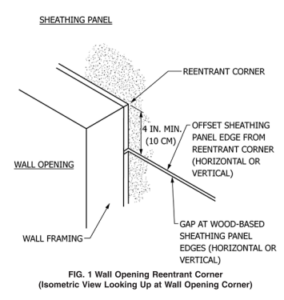
Section 6.1.1 framing member deflection shall not exceed L/360
Section 6.1.4 wood-based sheathing edges shall be offset a minimum of 4 inches from wall openings (see Fig 1) .
SMA Commentary: Many installers felt this was great news, the problem is if the stucco is removed and the joint is within 4 inches of the reentrant corner, you may be deemed in nonconformance to ASTM. Walk your project and at least notify the general contractor it may be an issue. Document that you pointed it out, particularly if they refuse to fix it.
Section 6.1.5 wood framing shall have a moisture content not to exceed 19% immediately before plastering
Section 7.2.4: damage to the WRB shall be made with the same or an alternative material compatible with the water resistive barrier before plastering.
Section 7.2.5: Z furring is now considered a customized furring system and shall be engineered.
TABLE 1– Flat rib lath is no longer permitted on unsheathed walls – Hi-rib is no longer permitted on all walls.
New ASTM – Refer to ASTM C 1861 for instructions on trim accessories
Section 7.3.2.4 Except for weep screeds, designated drainage screeds with solid flanges, the water-resistive barrier shall lap the flange of the accessory.
SMA Commentary: Short Flange casing has been used for several decades with no issues. The SMA agrees that “expanded” flange casing should not be covered, but short-flange casing, reveals and other may be covered, it is more of a design and intent issues. The SMA will stand with “alternates” on a case-by-case basis.
Section 7.3.5.2 Lath to concrete or masonry. Attachment is now prescribed as 16-inch OC as if the wall is framing with ¾ inch penetration.
SMA Commentary: The SMA still stands with one fastener per square foot is an acceptable practice.
SMA writes letters on a daily basis covering a variety of issues. Including code interpretation as well as ASTM interpretation. The SMA has been very successful with building departments when an interpretation on ASTM language is needed. EXAMPLE: Both old and new ASTM C1063 call for discontinuous lath behind a control joint. Continuous lath is routinely done and is a recognized industry practice by the SMA.
JOB PROBLEM OF THE MONTH
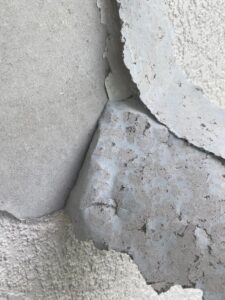
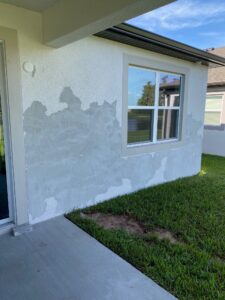
The SMA gets calls and emails from all over North America on stucco related concerns and troubles. With modern technology and camera phones, pictures can help make the story come to life. The goal of this new section to make contractors aware of issues and hope to help them avoid these issues themselves. There is no shortage of case files.
In Florida it is common and recognized to apply a lace texture to the brown coat and then paint as the final decoration. This homeowner could not understand why the paint was peeling off the stucco. While it could be considered a paint issue, the paint pulled off the stucco texture with it.
The SMA determined there were two issues
1. The cement texture was watered down to allow for workability, and possibly an additive. This resulted in a weaker than normal cement to cement bond.
2. The paint was applied only a few days later. The high alkalinity of the cement caused what is known as pH or alkalinity burn. This resulted in a breakdown in the binders used in paint. Paint should not be applied until the pH is near neutral (7)
NOTE: No weep screed was used because the plaster is over a solid masonry wall. This is code compliant and unrelated to the paint/stucco failure issue.
PLEASE NOTE: SMA OFFICE CONTACT INFORMATION
Mark Fowler, Executive Director
Marlene Lampert, Office Manager
Stucco Manufacturers Association
5753 E Santa Ana Cyn Rd, Suite G-156
Anaheim, CA 92807
Office: 714-473-9579
Mark@stuccomfgassoc.com
Marlene@stuccomfgassoc.com
REMEMBER: The SMA has a fairly large library on all things stucco. Members of the SMA are encouraged to call the SMA office if the staff can be of any assistance.
Fall 2021 eNews
FROM THE SMA EXECUTIVE DIRECTOR

Mark Fowler, SMA Executive Director
The Stucco Manufacturers Association (SMA) is working hard to promote stucco. Even with Covid keeping our in-person meetings to a minimum. The SMA has been doing a variety virtual meetings, classes and assistance to the architectural community. As codes and standards increase in complexity, they will need more and more help. The SMA is there for them. The SMA is a non-profit association representing the industry as a whole, not a single manufacturer, not a specific system or contractor, but all the industry. This makes the SMA a little unique and gives us influence. The SMA does not turn down or charge a fee to anyone calling in for assistance. Architects, general contractors and building owners look at the SMA as a kind of Consumer Reports group on steroids. The SMA also works hard to make sure members products and services are listed and referenced in project specifications. The SMA will recommend specific products when a perfect fit is noted or asked if there is a recommendation, this happens a lot.
Many designers are finding the SMA Contractor certification program particularly useful. Only a state license with the lowest bid is not much assurance the contractor is qualified to do the work. The SMA now has certified contractors in four states and expanding. Recently we even had an inquiry from England. The reviews of the six modules of training are overwhelmingly positive. The most impactful and relevant comments come from installers ( lathers and plasterers) who say they learned something new. If you have not checked out the modules yet, they are free, yes free to everyone to watch (online training program). The SMA felt it was important to make an effort to standardize industry practices, yet still allow for regional preferences. The goal is to make this a wide spread program that is nationally recognized and there is a powerful reason why. The SMA recently sat with one of the overall Insurance industries board of directors and she thought our program was great and compared it to the national roofing industry program, those contractors enjoy reduced premiums as the insurance industry feels more confident in their work. However, that group is more wide-spread as compared to us as we are just getting started. The insurance industry is looking to us to hopefully make a difference. Promoting the SMA certification program is a step to reduced risk for them and lower insurance premiums for you. What is the cost of certification? It is essentially free to SMA members. The future is in your hands, it is your industry and action or inaction will direct us all. (How to become Certified)
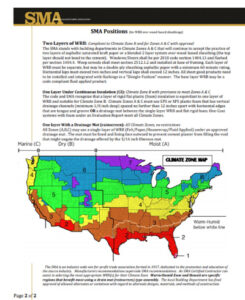 INDUSTRY NEWS
INDUSTRY NEWS
New 2021 code- the new International codes have significant changes when cement plaster is applied over wood-based sheathing. For the first time the codes mandate variations in application and design with regard to Climate Zones. The climate zones would technically be more appropriately called “moisture” zones. There are three of these zones for the United States A (moist), B (dry) or C (marine). The SMA has been giving classes to installers and even building departments on this new change. You maybe thinking “I have not seen this on my project, how can this be true?” The code cycle is every three years and the international codes come out first with state and local codes following in the next few years. So, get ready, it is coming as it has been written and published, just yet to be enforced. If you have not downloaded the SMA Tech Times bulletin on this topic, consider doing this soon, at least before the code hits you in the face. A word of caution, in litigation ignorance of the law, particularly when it is very industry specific, is not typically a viable defense. Be informed, be prepared.
MARKET NEWS
EAST vs WEST
While drywall is used with great regularity around the United States, stucco is only popular in some pockets or regions. Many believe that stucco is only suitable for warm dry climates. This explains why stucco is so popular in Southern California, Texas and Florida. Yet, it is hard to imagine Florida as dry. It maybe more accurate to state some believe stucco is NOT suitable for snow regions of the country. Due to freeze thaw concerns. However, the Swiss and Germans have used and continue to use cement stucco all the time. The truth is stucco works in all climates. High moisture areas simply require a little more attention to flashings, cold or snow regions require thinking of snow drifts, but it is not difficult to make stucco work anywhere.
The southern sections of east and the west coast are both popular stucco markets. With contractors’ members in all regions, the SMA must be adaptable to each region. The sad truth is that many experts in a region feel their way is the “only” way to install lath and plaster. This is what makes the ASTM committees a hot bed of in-fighting. They rarely agree on anything and seem unwilling to capitulate the other side has a proven regional practice. This explains why many contractors on both coasts routinely turn to the SMA for help with clarification on standards and allowed industry practices. Some feel we need a single inflexible standard with no allowances for regional practices, but how could that possibly work? Adding to the fact the international code has now set a precedent of regional practices by implementing the three climate zones with very different installation practices, it seems impossible. Whether we like it or not, there are regional practices and preferences. Most on the east coast refuse to use woven wire lath and that is fine. But the SMA will not state it is illegal. Here are some generalities about each coast of the USA regarding stucco.
WEST COAST: Pumping cement plaster is king in the west. The crews have mastered the art of machine application and the result is lower installed costs on basic residential tract work. It is so low, that vinyl siding has a hard time competing against stucco. This in turn allows custom homes to look at smooth trowel plaster. The added cost of the base and mesh to reduce cracks have made smooth trowel plaster the once hated finish to a preferred and affordable finish in the high end markets. One coat stucco is also gaining popularity , mostly in the residential market due to the Tongue and Groove insulation providing continuous insulation. More good news, these systems have been tested and meet the more stringent code requirements for enhanced drainage for Climate Zones A and C. Commercial work is primarily three coat stucco for durability and the inherent fire ratings in the code. While there are slight changes on the west coast from south to north, installations are similar. Stucco is just less popular as you move further north up the coast. Ironically, the use of the plaster pumps is also less popular moving up north and can impact installed costs.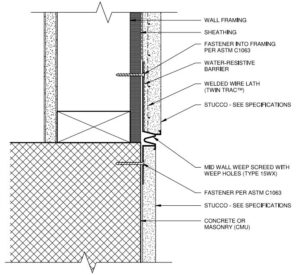
EAST COAST: The similarity for the east coast is the stucco market shrinks moving north, but does not seem to be related as much to machine production rates as other factors. Florida is the big market in the east. Unlike California, there is a major difference in application from south to north. In the southern part of the state, walls are mostly Concrete or CMU. The plaster becomes a parge coat and a finish may or may not be applied. Most stucco is painted. Elastomeric coatings are fairly popular. The vapor drive is opposite of the rest of the country, so that may be the better method of installation in that region. Moving north in Florida, projects start to see stucco on framing. It is also common to have the first floor CMU and the second-floor wood framing. This resulted in a massive number of leaks as the designers and installers failed to install a functioning weep device at the transitional floor line. That has been rectified and it is now common to use the PVC mid-wall weep screed as pictured. Both Plastic Components and Clark Dietrich manufacturer these products. They both have proven effective to stop the leaks.
TECHNICAL CORNER
COLD WEATHER PLASTERING
Cold weather is approaching. In parts of Canada, tenting the work is common practice. In really cold areas, they wait until Spring. It is true that freezing cement is a potential issue and should be avoided. Freezing stops the hydration process. This means the cement plaster does not get hard. The fear of freezing cement so great that manufacturers and ASTM prescribe that plaster should not be applied in temperatures below 40 degrees F. The SMA has experience in cold weather plastering with projects in Alaska, Minnesota and more moderate cities like Seattle. Many regions get cold, really cold and plastering should stop. However, much of the country is like Seattle. A kind of mix of sleet and frost. A Seattle pattern can be just below 40 F in the night and over 50F during the day. This is not an issue for Portland cement plaster. Cement plaster does not freeze easily. The temperature would have to be below freezing for at least a few hours for the cement to freeze. Even if it did, it can often be brought back the next day with minimal damp curing when temperatures climb above 40F. This also does not impact the cement plasters service life or its fire rating.
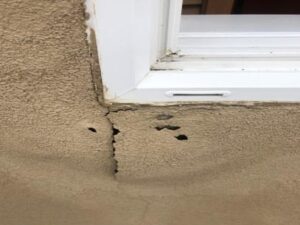
Acrylic finish coats are another story. They must be allowed to dry. Cement sets as it cures, we tend to say acrylics dry to a cure. While not technically accurate, it is better thinking this way. In addition, the acrylic dries from the outside in, as opposed to cement that cures from the inside out. What can happen is the acrylic gives what is called a “false set” on the surface. It may feel hard and cured, but is still soft against the cement plaster basecoat. If temporary protection protecting the acrylic finish is removed to soon, the set (cure) will never take place. The first rain or water can create bubbles or wash the acrylic off the basecoat. See picture . This is why plasterers in regions with temperatures than dip near freezing are very careful about using acrylic finishes in cold weather.
SMA BOARD OF DIRECTORS 2021
At the most recent SMA board of Directors meeting , Rick Durham was selected to be President of the SMA. Rick is from Texas and has a long history in the plastering industry. He was a plasterer and is a valuable resource to many of the contractors in his region. Rick has served on the board for the Texas Lath and Plastering Contractors Assoc (TLPCA) . as well as the National One-Coat Stucco Assoc (NOCSA). Currently Rick is running EZ Wall Concentrate, a producer of quality bagged cement products including basecoat stucco and tolling operations. Rick Durham believes in stucco and hopes to unite our efforts to preserve and grow the stucco market. He focuses on market share for our industry and limiting risks that plastering contractors face. His expertise and leadership will be helpful to guide the SMA into this new decade. Your SMA board of Directors:
Rick Durham- President (Texas)
Kevin Wensel-Vice President (California)
Justin Fleming- Treasurer (Florida)
Thom Susko – (California)
Herman Guevarra – (Florida)
Gary Goodwin – (Arizona)
DJ Farley – (California)
Dale Nehls – (Colorado)
NEWEST SMA CERTIFIED CONTRACTORS
Orlin’s Stucco – Florida 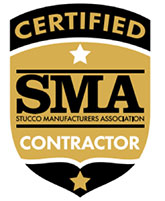
Prime Wall Systems – Texas
Onyx Group – California
Ronparco -Texas
SMV Stucco – Florida
HPS llc – California
Not Certified? It has benefits, strengthens our industry and works to lowering risk and reduced insurance premiums.
Get certified for the industry and yourself.
Please feel free to call the SMA office if we can be of any help.
Respectfully,
Mark Fowler , Executive Director
PLEASE NOTE: SMA OFFICE CONTACT INFORMATION
Mark Fowler, Executive Director
Marlene Lampert, Office Administrator
Stucco Manufacturers Association
5753 E Santa Ana Cyn Rd, Suite G-156
Anaheim, CA 92807
Office: 714-473-9579
Mark@stuccomfgassoc.com
Marlene@stuccomfgassoc.com
REMEMBER: The SMA has a fairly large library on all things stucco. Members of the SMA are encouraged to call the SMA office if the staff can be of any assistance.
Spring 2021 eNews
FROM THE SMA EXECUTIVE DIRECTOR

Mark Fowler, SMA Executive Director
STUCCO LIVE! is back. The World of Concrete convention will be held June 8-10, 2021, at the Las Vegas Convention Center. As with previous years, the SMA will partner with the OPCMIA to put on live presentations of cement plaster applications. A focus will be on the new International Building Codes requirement regarding water-resistive barriers when using cement plaster. Please read Been Doing This for 30 Years (see below) to learn more.
STUCCO LIVE! has been moved to the North Hall, next to event registration. We hope you can swing by and say hello. There will also be live classroom education this year by the SMA on the lathing and plastering modules of our Stucco Training Course. Attendees to the class will qualify to take tests for the online training cards and start the certification process. Each class is 90 minutes long and suitable for novices and experts in the plastering industry.
“Been Doing This for 30 Years”
Many of our contractor members are old pros. Your experience and knowledge is invaluable, and far be it for the SMA to tell you how to do stucco. Stucco has been around a long time and, while the codes have changed, stucco has not. What you did when you were young probably still works. Even if dragged into court, your old ways can be defended, and the SMA stands with you on these tried-and-true practices.
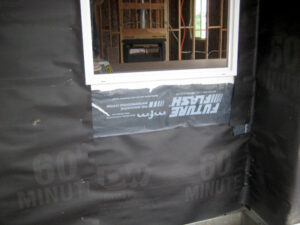
However, 2021 is a change – a big change for stucco. Old-timers have been putting on two layers of black paper over wood-based sheathing for decades. We did it before it became part of the building code in 1982. Even with recent tweaks to the code, it was still business as usual. NOT ANYMORE.
Section 2510.6 of the 2021 International Building Code has changed all the rules. The International Residential Code has followed suit with highly similar language.

This new code language will likely put stucco at a disadvantage compared to other competitive claddings in the fight for cladding market share. Besides a likely loss of market share, the new code is confusing, and the SMA office has been contacted and asked many times for clarification. SMA contractors may have already seen the language and are likely scratching their heads. You are not alone: everyone is confused.
SMA Virtual Membership Meeting: May 12
Our SMA Member Meeting – on May 12th at 11:00 am (Pacific time) – will present our SMA Technical Paper written to cover the new IBC information and provide clarification and some guidance.
We know you have questions. Are two layers of asphaltic paper still allowed? What does Climate Zone A, B, or C mean? The reality is there are experts out there just looking to play gotcha. They want to tear into your stucco and say to the owner, “Code Violation.” This can impact designers as well. We have all seen outdated specifications, with products listed and manufacturers long out of business. It is not hard to imagine two layers Grade D being used and a consultant rubbing their hands together, thinking it is now payday for them. There are still some options left to us, just not as many as before.
The SMA will cover these options in our virtual SMA membership meeting on May 12 as we introduce our newest technical paper intended to educate and help you protect yourself. [Register in advance for this meeting. After registering, you will receive a confirmation email containing information about joining the meeting.] REGISTER NOW—>>
Silica & OSHA
The news on silica is that the OSHA has directed all regional OSHA offices a National Emphasis Program (NEP) that directs them to identify and reduce worker exposures to respirable crystalline silica (RCS) in general industry, maritime and construction. The NEP targets specific sectors expected to have the highest exposures to RCS.
As a directive from national to all regional offices, it will be taken seriously – so should all SMA employers. Verify your written exposure plan is up to date: the SMA has the new plan ready, and it is free to members. SMA also offers competent person training as part of our online Stucco Training Program that can be viewed at your supervisor’s convenience.
The rule also requires you to train or “educate” your workers on silica exposure. The SMA has a free eight-minute video to cover the very basics for workers. There is a five-question quiz. Silica dust is not a joke; neither is being fined. Protect yourself.
We also offer a Toolbox Talk sheet for the foreman which has all the topics listed that OSHA employers must convey to workers regarding silica exposure.
Make sure you are part of the SMA Silica Exposure Program and listed on the SMA website as a member. This allows you to verify to others your firm is part of the program from your smartphone. Protect yourself – it is free and easy to do as an SMA member.
TRADE TIP: Floating the Basecoat
Lath and plastering are skill-intensive trades. However, it is often overlooked that they are also knowledge-based. Knowledge can come from experiences, classrooms, or mentoring. Experiences, particularly the hard lessons of failures, are the worst and most painful method. Classroom education is excellent but sometimes better suited for trades like electricians or HVAC workers. Lath and plastering have traditionally relied on mentoring. This is when the old craftsmen teach the young the how and, most importantly, the why. Mentorship works but requires mentors and willing students. Both seem to be in short supply for the industry.
The SMA will now start a section in each newsletter called the Trade Tip. This will be a tip in the trade of lathing or plastering that old mentors would have typically passed along to those entering the craft.
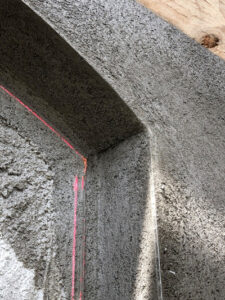
This Tip deals with what the industry calls “hard floating” the membrane. Floating the brown or basecoat is meant to clean edges, terminations and prepare it for the finish coat. But floating is more than that. Floating the cement plaster should also consolidate and densify the cement plaster membrane. A properly densified ¾ inch cement membrane is more resistant to cracks and water penetration. This is not theory but fact. If this is not enough to convince nonbelievers, it is required by ASTM C-926-19 Section 7.4.2.2 “… floated uniformly to promote densification of the coat… .” Timing and tool selection are critical to float the cement plaster properly.
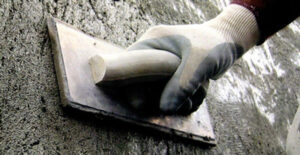
A hard float is one with wood, cork or neoprene material. A green, tan or red sponge is not a hard float. Floating is best done when the plaster has lost the excess mix water needed to apply the cement plaster, but before it starts to set. There is a window of opportunity for timing. A tip on timing is to push the hard-float to the wall. When it does not stick, the wall is ready to float. What must not occur is to have the cement membrane move under the pressure of float. Another image to consider is a ¾ inch raw steak. Pushing on it moves the mass as it shifts under pressure. When the excess moisture has evaporated, the shifting stops and densification can be achieved. The pressure applied to the float only has to be moderate to achieve proper densification.
Plastering is not the only industry that relies on the densification of a cement membrane to achieve a sound membrane. The cement terrazzo flooring industry has a similar practice. They pour up to two inches of pigmented cement with marble chips and no sand. They patiently wait until excess mix water begins to evaporate, and then they start to roll the terrazzo with a large, heavy roller. The act of rolling densifies and compacts the cement. Without the rolling of the cement, they would have excessive cracking and a weak terrazzo floor. They keep this practice alive by good mentoring. They know this is what leads to a long-lasting, crack- and water-resistant floor. Like plastering, ignoring a critical part of the operation can lead to problems.
The Insurance Blues

The SMA is aware our good plastering contractors see increases in liability premiums. Rates are climbing fast and high, even for those with a flawless track record concerning claims. We know many contractors see these insurance premiums impacting their bids and making it tougher to compete with other claddings.
If you think this is an accident or coincidence, it is not. Groups are trying to take the stucco market, and increased premiums coupled with fear to designers is a proven tactic. Think of what the EIFS industry went through.
We have heard you and are trying to do something about it. The SMA has been busy building a bridge with the insurance industry. The insurance industry has a research center in South Carolina where they fund testing roofs, concrete, walls, and other systems. The result is new codes, insurance policy procedures as well as policy exclusions. It is hard to understate the importance for the plastering industry to be working with them.
The SMA has offered a helping hand in the development of various walls to be tested. They appreciate the help and eventually told SMA they would work to get SMA on the committee overseeing building envelopes related to insurance issues. As far as we know, no one from the plastering industry has ever gotten this far with the insurance industry. It may be our chance to not only be heard but play a role in what happens in the future to your insurance policies and premiums.
SMA trips to South Carolina will be a strain on the SMA budget and resources. Mergers of corporate giants have impacted the revenues of the SMA’s future. In short, SMA needs our members’ help, particularly the contractors. First, you have the most skin in the game, and you have the power to make SMA a stronger voice in the industry. The SMA does not need more money from you – instead, SMA requires more suppliers and manufacturers to join our collective fight for our industry.
How can you help? Tell your material suppliers and manufacturers to join the industry and support our collaborative efforts. We can, working together, help lower insurance costs, protect contractors at the code level and make stucco a stronger market and a better market. We are all fighting for the same thing and, as their customer, they will listen to you. If they reply, “we are SMA members,” thank them for their support. If they ask “why should we join?” tell them we are ALL trying to protect our collective market. Join us and be part of the solution. The SMA believes, all together, we could be a strong and influential voice to the insurance industry.
SMA Contractor Certification
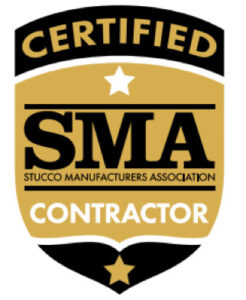 Congratulations to the latest batch of SMA Certified Contractors. They have taken the required training classes, passed the testing, and cleared with references to verify they’re part of a higher group. Architects are starting to add SMA certifications to their project specifications in South Carolina, Louisiana, Colorado, Illinois and California. The SMA board of directors approved these certifications at the last board meeting.
Congratulations to the latest batch of SMA Certified Contractors. They have taken the required training classes, passed the testing, and cleared with references to verify they’re part of a higher group. Architects are starting to add SMA certifications to their project specifications in South Carolina, Louisiana, Colorado, Illinois and California. The SMA board of directors approved these certifications at the last board meeting.
Prime Wall Systems
LLC Hutto, Texas
Onyx Building Group
El Cajon, California
SMV Stucco Inc.
Orlando, Florida
Ronparco
Euless, Texas
HPS (Home Plaster Shop) Inc.
San Clemente, California
PLEASE NOTE: SMA OFFICE CONTACT INFORMATION
Mark Fowler, Executive Director
Marlene Lampert, Office Manager
Stucco Manufacturers Association
5753 E Santa Ana Cyn Rd, Suite G-156
Anaheim, CA 92807
Office: 714-473-9579
Mark@stuccomfgassoc.com
Marlene@stuccomfgassoc.com
REMEMBER: The SMA has a fairly large library on all things stucco. Members of the SMA are encouraged to call the SMA office if the staff can be of any assistance.
Fall 2020 eNews
FROM THE SMA EXECUTIVE DIRECTOR

Mark Fowler, SMA Executive Director
I think it is fair to say that 2020 sucks, and we cannot wait for it to end. The SMA hopes we can go back to normal sometime in 2021, but even that is not guaranteed. I run two national associations for construction trades, and it is clear: things will change. Similar to 9/11, this too will pass but likely shift our landscape forever. Most likely, those who fail to adapt will suffer. Some changes will be dramatic, others subtle, but at the end to this decade, they will all be clear to us. The question is, what will we be saying as we look back? Did we see the trend shifts and make the required adjustments? I hope you think seriously and agree we need to be on it or get run over. The Code Update section is an excellent example of changes likely to come.
It is not all bad news. The SMA board has been on the forefront to make industry changes, not to survive but thrive in the coming decade. This newsletter will focus on the various SMA programs. Some are in place, like the Silica Compliance Program; others are new and just kicking off, such as the SMA Stucco Training Modules and the SMA Contractor Certification Program. We will also introduce you to the SMA Quality Assurance Program that is under development. This newsletter will cover each program and be your guide to where the SMA thinks the industry is going and how the SMA can help your stucco and your business succeed.
The SMA plans a Webinar soon to explain these programs in greater detail and answer member questions.
SMA Silica Compliance Program
The SMA Silica Compliance Program continues to be an industry-leading program. Respirable silica dust is a serious issue. Just as serious is the employer’s responsibility to protect their employees. The SMA has a proven written exposure plan for your company – specific to plastering and adhered masonry. Our YouTube channel has the “Silica Awareness” video covering the minimum items you must cover with all employees. The SMA also offers “Competent Person” training and a card to verify the training. All in the Silica Program is FREE to SMA contractors, including the required written exposure plan, the toolbox talk sheets in English and Spanish and the training we offer with testing. Consider the SMA Silica Program similar to auto insurance. Getting in after an OSHA fine is the same as asking your agent for insurance after the auto accident, too late now. Being an SMA member helps protect you.
Why a Stucco Training Program?
Why do we need this? First, it is still a free country, and no one will force you to anything against your will. But most seem to agree, we do not have the training programs required, and while these may not be perfect, they are a good start.
Stucco market share grew and then suffered a setback with leaky buildings. Of course, all buildings leaked, but stucco was an easy target for litigation. Not all regions of the country were impacted equally, nor are the after-effects the same. Why?
- Stucco is easy to attack because it is site fabricated.
- Stucco has more variables than other claddings.
- The industry has lacked a collective voice and fragmented.
- We have some bad actors out there. And since low bid is king, they can continue.
- Codes and standards are changing fast, making it hard to keep up.
The result is stucco is the easiest cladding to attack and hard to defend with mixed messages, codes changing as fast you can blink. The workers in the field hardly stand a chance, as well as the supervisors.
The SMA set out to help with one voice, acknowledging regional allowances for the industry and a solid defense plan. The SMA has put the modules (classes) on the new SMA YouTube channel. Clicking like and subscribing helps the SMA and the industry be a collective voice. The first step is simply a couple of clicks that cost us nothing; we hope you start there to help our industry.
SMA Online Video Training:
Modules 1-5 – Lath & Plaster
The SMA Online Video Training has five 30-minute training modules on lath and plastering. Modules 1 and 2 are lathing, 3 is material, and 4 and 5 are plastering. It is NOT merely code memorization; these are trade tips for the workers in the field. The SMA believes it is critical that trade workers understand the WHY. Why lap housewraps/paper to flashing and how? Why you should counter flash kick-outs? Why hard float the brown coat? We also include trade tips, such as cutting casing beads more efficiently, improving production using the hawk and trowel, and how to cut angles in wet cement plaster. Module 4 covers the plaster pumps, different types, how they work, and tips on using these production masters. Module 5 covers the finish coat. Focus is devoted to doing a quality smooth trowel cement finish.
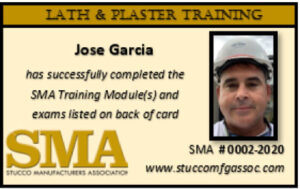 Overall, these modules will be great for those getting started in lathing and plastering as well as seasoned pros. They are all free to the public on the Stucco Manufacturers Association YouTube channel and on our website.
Overall, these modules will be great for those getting started in lathing and plastering as well as seasoned pros. They are all free to the public on the Stucco Manufacturers Association YouTube channel and on our website.
For those wanting a training card to verify taking the class, the SMA can offer a picture card with an SMA registration # after passing a 50-question test on the website. The processing fee is $75 per test. If a person wants to take lath and plaster (100 questions), the fee is $100. We allow a person, should they fail, to re-take the test at no extra charge, but they must wait 30 days. The courses passed are listed on the back of the card.
Module 6 – Supervision
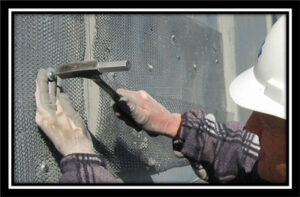
This is the SUPERVISOR course. The Supervisor course includes Modules 1 through 5. Module 6 (Supervisor) includes a manual for lath and plaster supervisors and is the gateway to certifications. This course material covers leadership skills, documentation of events, building science, and how to use SMA technical bulletins to do better stucco and protect the building owner and the contractor. Supervisor training/education has never been available to the stucco industry. The course material has been vetted by experts in defect litigation, building science, and leadership skills, with a focus on lath and plastering. Module 6 is the gateway to SMA Contractor Certification.
SMA Contractor Certification
 The first requirement of the SMA Contractor Certification is to have an SMA supervisor on staff. The process verifies the leadership has been trained and educated on lath and plaster. A contractor can send an employee or take the test themselves. If the SMA supervisor leaves, certification will follow that supervisor. Contractors should consider who they want to have approved. SMA Contractor Certification requires being in business for over two years with verifiable references and includes a background check. Approval is by the SMA Board of Directors, and the board can revoke certification. The cost is $500 for SMA members. However, to thank our contractor members, the SMA offers to put the $500 certification fee toward your next year’s annual dues. This essentially means it costs current SMA contractor members nothing to get certified. It is the board of directors saying thank you for supporting the program and the SMA. Upon approval by the SMA board, the contractor can use the “Certified” logo on letterhead, equipment, or other approved places. An SMA letter will be sent to verify you are SMA certified that you could use to submit with bids. Certification demonstrates your company is a step above the competition. Because the low bid is not a fair selection process. Non-SMA members can become certified for $1495.
The first requirement of the SMA Contractor Certification is to have an SMA supervisor on staff. The process verifies the leadership has been trained and educated on lath and plaster. A contractor can send an employee or take the test themselves. If the SMA supervisor leaves, certification will follow that supervisor. Contractors should consider who they want to have approved. SMA Contractor Certification requires being in business for over two years with verifiable references and includes a background check. Approval is by the SMA Board of Directors, and the board can revoke certification. The cost is $500 for SMA members. However, to thank our contractor members, the SMA offers to put the $500 certification fee toward your next year’s annual dues. This essentially means it costs current SMA contractor members nothing to get certified. It is the board of directors saying thank you for supporting the program and the SMA. Upon approval by the SMA board, the contractor can use the “Certified” logo on letterhead, equipment, or other approved places. An SMA letter will be sent to verify you are SMA certified that you could use to submit with bids. Certification demonstrates your company is a step above the competition. Because the low bid is not a fair selection process. Non-SMA members can become certified for $1495.
SMA Quality Assurance Program
This program is currently under development. The concept is pretty simple. The SMA Certified Contractor will receive forms and checklists that they may use. The program is not mandatory. The form verifies materials, flashing, and procedures, with room for comments and pictures. The report can be printed and given to the building owner. The report can be used later should questions arise, particularly when the building is sold. The report can provide future inspectors a comfort level with what you did under the stucco.
Besides sending this to the building owner, a copy may be sent to the SMA vault. The SMA will keep these reports for ten years. At that time, the statute of limitations expires, and records are far less critical. Should a consultant opt to file a lawsuit against the SMA Certified Contractor who has put in a file for that project, the SMA will have a record and provide comments as an authoritative source on industry practices. The SMA opinion can help contractors and their insurance carriers better protect them against frivolous lawsuits. For those worried about the program, it is 100% voluntary, but taking pictures (which the SMA recommends, which locations to take them) can often help contractors spot minor defects as well, allowing them to make needed adjustments. If work under the stucco is done per industry practice, this evidence can provide a strong case that intrusive investigation is not warranted. Because once they start cutting into the stucco, it tends to be a point of no return. The forensic group will tend to want to justify the reasons for cutting into the stucco. The report (pictures) can help identify errors, be a good defense and provide a comfort level to others.
CODE UPDATE: ALL ABOUT THE WRB
For decades it was pretty simple for plastering contractors; we all used asphalt-treated kraft paper water-resistive barriers (AKA “black building paper”). We knew there was a Grade D for stucco, and it could be 10, 30 or 60 minute-rated. We also knew we had to put two layers over wood-based sheathings. Get the laps right, and you’re good to go. That world is long gone. Today there is a mind-numbing amount of selections of WRB products, and the codes have changed significantly. You need to read and understand this.
COMMERCIAL
International Building Code (IBC) section 2510.6 (commercial) has replaced the term Grade D with ASTM references. Grade D is now referred to as compliant to ASTM E 2556. Type I is 10-minute, and Type II is 60-minute Grade D.
2018 Code: 2510.6 Water-resistive barriers.
Water-resistive barriers shall be installed as required by Section 1403.2 and, where applied over wood-based sheathing, shall include a water-resistive vapor permeable barrier with a performance at least equivalent to two layers of water-resistive barrier complying with ASTM E2556, Type I. The individual layers shall be installed independently such that each layer provides a separate continuous plane and any flashing (installed per accordance with Section 1404.4) intended to drain to the water-resistive barrier is directed between the layers.
SMA Policy: This language, while well intended, is confusing and not always possible when two layers of water-resistive barrier are applied and integrated with flashings. Besides making it virtually impossible in cases to fully comply, double-layer kraft paper has been used for several decades with no evidence that this method of application has been an issue for water intrusion. Fortunately, there are 2 (two) exceptions to the above code requirement that provide relief and options.
Exceptions:
1. Where the water-resistive barrier that is applied over wood-based sheathing has a water resistance equal to or greater than that of a water-resistive barrier complying with ASTM E2556, Type II and is separated from the stucco by an intervening, substantially nonwater-absorbing layer or drainage space.
2. Where the water-resistive barrier is applied over wood-based sheathing in a Climate Zone 1A, 2A or 3A, a ventilated air space shall be provided between the stucco and the water-resistive barrier.
Exception 1: The SMA sees this as primarily allowing one layer of water-resistive barrier to be substituted for rigid foam or a drainage mat. We fully support this option. One-coat stucco has been doing this for decades with great success. Some experts feel that this excludes asphaltic paper. The SMA does not agree and states that asphaltic kraft paper (Grade D) absorbs “minor” amounts of water, enough to wrinkle, but do not “substantially” absorb water. To verify this claim, if substantial amounts of water were absorbed into the kraft paper, the thin scratch coat of fresh cement would never cure as too much water would be taken from the cement. Flash drying in cement scratch coat occasionally occurs, but only in hot, dry, and windy weather. It is the weather that dissipates the moisture. This means the separate layer rule is also negated for asphaltic papers. Mixed water-resistive barrier products would require two separate planes. The SMA recommends that these assemblies have the house wrap product applied first and a layer of ASTM E 2556 over that.
Exception 2: These climate zones are established by ASHRAE. In short, they cover most of Florida, Texas, Louisiana, South Carolina, Mississippi, Georgia, Alabama, and parts of North Carolina, Arkansas, Tennessee, and Oklahoma. Your architect/designer should verify the zone. The ventilated space means with assembly requires a drainage mat under the stucco when applied to wood-based sheathings. California is currently exempt, but this requirement for stucco is likely coming in the next few years.
RESIDENTIAL
The International Residential Code (IRC) language on stucco WRBs (section R703.7.3) is very similar to the commercial (IBC) code, except it still references Grade D paper. It also has exceptions as well. Exception number 2 replaces the term “ventilated air space” with a “designed drainage space.” They have also left out any Climate Zone references, thereby adding even more confusion.
The SMA understands that the IBC is intended for commercial structures by covering more relevant buildings such as multistory, hospitals, and schools. The IRC is strictly for duplexes and single-family homes.
This now introduces the term “Drainage Space.” Fortunately, ASTM E2266 is a standard that covers the “drainage wall.” Per ASTM E2266:
A Drainage Wall: is a wall system in which the cladding provides a substantial barrier to water intrusion, but which also incorporates means for dissipating water that may circumvent the cladding. For purposes of this standard a drainage wall is assumed to incorporate a concealed weather-resistive barrier¹ over which drainage, away from water-sensitive components of the wall, may occur. In addition, to drainage behind the cladding, evaporation may play an important role in dissipating moisture in some types of claddings.
This seems to be written to define stucco with building paper over framed walls specifically. The cement plaster, properly mixed and applied, sheds the vast majority of the water. We accept that incidental water can circumvent the stucco and incorporate a concealed water-resistant barrier. Cement stucco also absorbs moisture and dissipates that moisture to the exterior. Some consultants refer to this a “reservoir” cladding. While some think of this as a negative, ASTM E2266 makes it a positive feature as Portland cement, unlike water-sensitive materials, is relatively unaffected by water.
FOAM SHEATHING
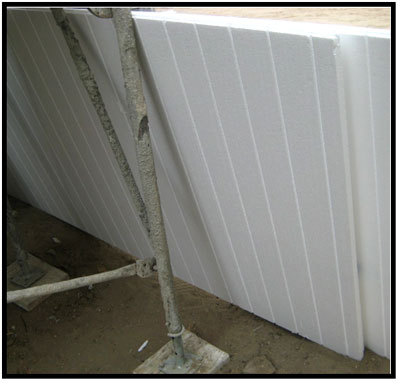
As Continuous Insulation continues to gain favor under exterior claddings, it stands to reason that codes have adjusted as well. Currently, the International Building and Residential Codes have many references to Foam Plastic sheathing; most are about cladding attachment and energy savings.
Exception 1: The code supports the use of rigid foam as replacing one of the two layers of the water-resistive barrier when two are required. While not required by the IBC, it is generally recommended to use a tongue and groove or a rigid board that incorporates drainage channels on the backside. The SMA rationale is that this is required for one-coat stucco through the Evaluation Report(s), and makes sense the commercial code is generally more restrictive due to the structure and occupancy coverage.
Another option is to use a drainage mat behind and the rigid foam to enhance drainage. Drainage between the foam sheathing and cement plaster applied to the foam will not occur. This is noted in the Portland Cement Association (PCA) Plaster/Stucco Manual under Coolers and Walk-in Freezers: “Portland Cement plaster bonds tenaciously to most insulation, such as polyurethane, polystyrene, and cork.” This tenuous bond, while structurally beneficial, will not allow for drainage. The SMA considers bonding of cement plaster to rigid insulation similar to stucco over masonry substrates. This also explains why most plaster bureaus encourage the water-resistant barrier to be under rigid insulation.
CONCLUSION
Always follow what the designer has specified. If you have concerns that the design may not meet code, you should request verification that it does indeed meet current code, but then proceed as directed. NEVER switch out or alter the water-resistive barriers to what you think is code minimum or put in products that you believe exceed the code for everyone’s protection without approval. DO NOT DESIGN: point out potential concerns, use SMA documentation to support your claim, and document the response. Protect yourself.
PLEASE NOTE: SMA OFFICE CONTACT INFORMATION
Mark Fowler, Executive Director
Marlene Lampert, Office Manager
Stucco Manufacturers Association
5753 E Santa Ana Cyn Rd, Suite G-156
Anaheim, CA 92807
Office: 714-473-9579
Mark@stuccomfgassoc.com
Marlene@stuccomfgassoc.com
REMEMBER: The SMA has a fairly large library on all things stucco. Members of the SMA are encouraged to call the SMA office if the staff can be of any assistance.
Summer 2020 eNews
FROM THE SMA EXECUTIVE DIRECTOR

Mark Fowler, SMA Executive Director
The year 2020 has not been what we expected. This pandemic has flipped just about everything upside down. Meetings canceled, offices empty and the extra cost to do just about any task seems to push the limit of just breaking even on a project. However, we will get through this as we have gotten through the depression, the great recession and the housing collapse. While finding a silver lining seems hard, there may be one out there. Your competitors—who are poorly funded, unskilled and should not be in business—may not be around to see 2021.
The SMA and its manufacturers want to help you succeed. One issue that has come up over and over is that the “trunk slammer” down the street will now be cheaper. They will claim they are the best value, and we all know the low price is hard to sway builders away from. But the SMA may be able to help
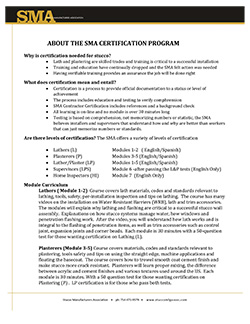 Introducing the SMA Certified Contractor. A simple fact is that many designers, builders and home owners want stucco but are scared it will be done wrong. And with only the price to go on, they typically pick the lowest bid. This is because even the low bidder is going to sell themselves as the most qualified. NOW, there will be a way to differentiate yourself from the low bidder. You are SMA certified.
Introducing the SMA Certified Contractor. A simple fact is that many designers, builders and home owners want stucco but are scared it will be done wrong. And with only the price to go on, they typically pick the lowest bid. This is because even the low bidder is going to sell themselves as the most qualified. NOW, there will be a way to differentiate yourself from the low bidder. You are SMA certified.
Learn more about our certification program here…
The program is designed to be national. It covers regional practices and variations between various states. What makes this program unique is that it is NOT merely code or standards memorization. The purpose of the program is to know WHY you do something and then HOW best to get it done. It is for the new lather and plasterer as well as the seasoned pro. We promise, the pro will learn something from watching the video modules. A Union-trained lather watched the video: “ I learned a lot and will lath my jobs differently in the future, all lathers should watch this program.”
See also the SMA’s introductory “Stucco Certification” training video [right sidebar] to learn more, or log onto the SMA YouTube channel and start watching. It is free.
SMA Board of Directors
Fall is the time we elect new officers to the SMA Board. There has never been a time that being on the board will be more impactful. The SMA Certified Contractor Program will require contractors to meet a variety of criteria. The final hurdle for the stucco contractor wanting approval for SMA Contractor Certification is a vote by the SMA Board of Directors.
SMA Events
The May meeting was, like all events, canceled. The SMA golf tournament is scheduled for October 19, and we still plan to hold that event. Sponsorship is available, and should the event be canceled, your sponsorship monies would be returned. Our next member meeting is scheduled for November 4. We are hoping that will take place.
Mark your Calendars for 2020
- October 19 – SMA Golf Tournament, Yorba Linda Country Club
- November 4 – SMA Membership Meeting, Yorba Linda Country Club
OSHA: Silica
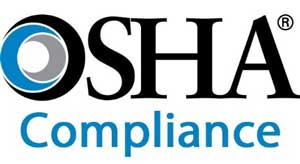 While things seem sleepy, OSHA announced that they will go back to stricter enforcement of the silica rules in 2021. On June 25th OSHA sent out a memo to all inspectors in various states regarding silica dust.
While things seem sleepy, OSHA announced that they will go back to stricter enforcement of the silica rules in 2021. On June 25th OSHA sent out a memo to all inspectors in various states regarding silica dust.
OSHA INSTRUCTION NOTICE
Notice of intent required. States are expected to have accessible enforcement policies and procedures in place which are at least as effective as those in this Instruction.
The SMA urges contractors to get their people trained. You need a Competent Person, and the SMA offers “free” training. The SMA also offers a very short “Awareness” video for your employees. This is not full training and only lasts a few minutes. But it can prevent your employees from responding to the OSHA officer with a statement such as “ What is silica, my employer never told me a thing.” Statements like this are red flags to compliance officers. Protect yourself and your employees. In a short eight minutes, they can be aware of silica, and the SMA even has a 5 question test that all should be able to pass easily after watching the video. This can really help if OSHA wants to see what you have done to protect your worker. The cost for members is ZERO. So you really have no excuse.
THE CODE CORNER
The technical section developed to help SMA contractor members better understand, protect and run their business.\
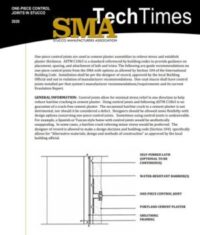 The SMA has introduced some new Technical Bulletins on the website. Some are about clarifying the intent of the code, others are there to help with issues that come up with designers, general contractors, etc.
The SMA has introduced some new Technical Bulletins on the website. Some are about clarifying the intent of the code, others are there to help with issues that come up with designers, general contractors, etc.
The Bulletins are for members to use as third-party documentation that what you have proposed is either code compliant or good industry practice. The SMA encourages contractors to use the SMA to help you in these tough times.
Problem Job of the Month
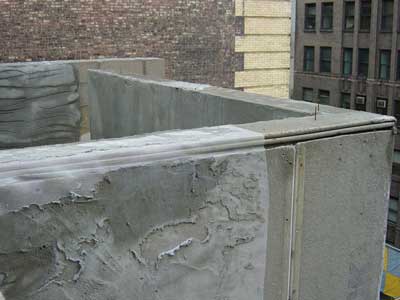 The SMA gets calls all the time on stucco and stucco issues. This call came in from New York. The owner was concerned that he could find nowhere in any publication that a scratch and brown coat was applied to a cement board. He also could not find the use of a fiber mesh in lieu of using a lath.
The SMA gets calls all the time on stucco and stucco issues. This call came in from New York. The owner was concerned that he could find nowhere in any publication that a scratch and brown coat was applied to a cement board. He also could not find the use of a fiber mesh in lieu of using a lath.
After a discussion on the phone, the plasterers told him that they do this all the time. They plan to put ¾ inch of cement plaster on the cement board. The SMA asked if a picture could be sent. Our staff was certain the building owner did not know what he was talking about. No plasterer would do this.
The picture came in and, yes, these guys not only planned, but were doing it. Apparently they told him, “What’s the difference, cement over CMU or cement board, same thing.”
They did not appreciate the SMA response, but our job is quality stucco not appeasing bad practices that lead to stucco failures. This was removed and the plasterers were let go. The owner found a qualified stucco installer who did it right.
PLEASE NOTE: SMA OFFICE CONTACT INFORMATION
Mark Fowler, Executive Director
Marlene Lampert, Office Manager
Stucco Manufacturers Association
5753 E Santa Ana Cyn Rd, Suite G-156
Anaheim, CA 92807
Office: 714-473-9579
Mark@stuccomfgassoc.com
Marlene@stuccomfgassoc.com
REMEMBER: The SMA has a fairly large library on all things stucco. Members of the SMA are encouraged to call the SMA office if the staff can be of any assistance.
Fall 2019 eNews
FROM THE SMA EXECUTIVE DIRECTOR

Mark Fowler, SMA Executive Director
Fall is upon us, and winter is fast approaching. For those in the stucco industry and not in the south, it also means you need to pay attention to the weather. Frozen materials may be chemically altered and create real problems. It is useful to remember that ASTM C-926-19 requires cement plaster be applied when the ambient air temperature is higher than 40° F (4.4°C), unless the work area is enclosed and heat provided (Section 7.9.3.2). Plaster shall also not be applied to frozen surfaces or a base containing frost. Plaster shall not contain frozen ingredients and protected from freezing for a period not less than 24 hours after set has occurred (Section 7.9.1)
Acrylic finish coats cure like cement. However, the SMA thinks of them as drying more than curing. The acrylic finish can form a hard outer shell and appear to be set. Some plasterers have made the mistake to pull down the scaffold and tenting as soon as the acrylic is hard. However, it must be made sure that the acrylic is cured and adhered to the base coat. If the protection is removed too soon, the first rains will likely cause blisters and delamination issues.
SMA ONLINE EDUCATION/TRAINING
The SMA on-line training program is still underway. We have contracted with a professional firm for translation into Spanish. The program will be released before 2020 arrives. Some contractors have expressed concerns about the program. Any contractor member is invited to participate in the review of the program. In fact, we strongly encourage more feedback. This is a national program and tries to include all regions and be inclusive of regional differences. The cost of the program has not been finalized by the board of directors, but they are well aware it must be affordable to all. The thought to provide the class for free is still on the table. However, if certification is desired, the workload would be substantial for the SMA and added staff would need to be paid. The intent of the program is to ensure the installers “do no harm” when installing lath and stucco. Stucco is an excellent cladding when installed with basic care and understanding of the system. Please see our introductory video [in the sidebar at right] for a preview.
SMA NOVEMBER 6 MEETING — REGISTER ONLINE NOW
 The next meeting for the SMA is November 6 at the Yorba Linda Country Club. [Register here] The speaker is Jacob Belk. Mr. Belk is a renowned forecaster of the residential construction economy. He worked at the Governor’s office, preparing industry forecasts to predict tax revenues, and is well respected for his advice. He spoke last year to the SMA and was well received by the members. He provided handouts that members have used all year to forecast and plan their businesses. His research is undeniably some of the best in the industry. The SMA has been working with Mr. Belk and is happy he feels we are a valued resource as well. His focus is on California, but other areas can learn from his presentation as well. The meeting and lunch start at noon on November 6.
The next meeting for the SMA is November 6 at the Yorba Linda Country Club. [Register here] The speaker is Jacob Belk. Mr. Belk is a renowned forecaster of the residential construction economy. He worked at the Governor’s office, preparing industry forecasts to predict tax revenues, and is well respected for his advice. He spoke last year to the SMA and was well received by the members. He provided handouts that members have used all year to forecast and plan their businesses. His research is undeniably some of the best in the industry. The SMA has been working with Mr. Belk and is happy he feels we are a valued resource as well. His focus is on California, but other areas can learn from his presentation as well. The meeting and lunch start at noon on November 6.
‘STUCCO LIVE’ RETURNS: Las Vegas, February 4-7, 2020
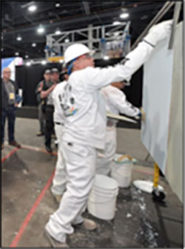 The SMA will again be hosting STUCCO LIVE at the World of Concrete in 2020. STUCCO LIVE 2019 was a great success — and special thanks to our friends at the Operative Plasterers & Cement Masons International Association (OPCMIA). The live demonstrations garnered large crowds to witness the pros at lath and plastering applying their craft. The skill was on display and the audience loved it. This year we’ll have live demonstrations highlighting various manufacturers’ products and systems. The show is February 4-7 at the Las Vegas Convention Center. The 2019 event had record attendance, and 2020 promises to be even bigger.
The SMA will again be hosting STUCCO LIVE at the World of Concrete in 2020. STUCCO LIVE 2019 was a great success — and special thanks to our friends at the Operative Plasterers & Cement Masons International Association (OPCMIA). The live demonstrations garnered large crowds to witness the pros at lath and plastering applying their craft. The skill was on display and the audience loved it. This year we’ll have live demonstrations highlighting various manufacturers’ products and systems. The show is February 4-7 at the Las Vegas Convention Center. The 2019 event had record attendance, and 2020 promises to be even bigger.
SMA GOLF 2019



Our annual golf tournament held on September 23 was another success. The Yorba Linda Country Club opened its brand new greens, and the course was in fantastic shape. Thank you to sponsors that make it all happen: Atlas Foam, Thompson Building Materials, La Habra Stucco, Merlex Stucco, Omega Products, Quikrete, CalPortland Cement, and PW Gillibrand Specialty Aggregates.
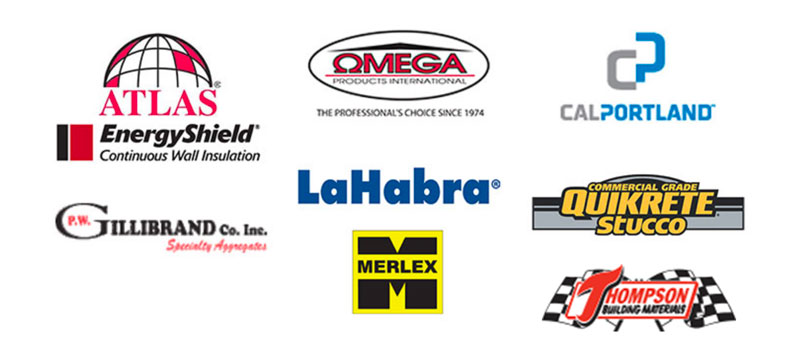
SMA BOARD OF DIRECTORS ELECTION
The SMA will soon be holding elections for an opening on the SMA Board of Directors. All members are eligible to serve. If you have the interest to serve on the SMA board, contact Mark Fowler at Mark@stuccomfgassoc.com. Being on the SMA board requires a commitment to time, and it is a responsibility not to be taken lightly. The SMA board implements plans and projects to better the overall stucco industry for the United States. It is not a platform to gain an edge on your competitors or focus on a single region of the country. The SMA board has an impeccable reputation as being fair and equitable for all. The SMA is blind to conflicts between signatory, merit even double-breasted shops. The Board is comprised of manufacturers, suppliers and contractors. This makes the SMA board unique in that the full industry is represented, nationally, and that we specialize only in lath and plastering.
Feature Articles
ASR — BEWARE
I have always said that plastering is a skilled craft; it requires trade skills and the knowledge that only the experience of working with it can bring. Unfortunately most of the experience that sticks with me is the witnessing of certain failures. This is why networking is so valuable to skilled trades. You can learn from others. ASR is an example and I had no idea what it was, and since working in the terrazzo side, it is a whole new world that stucco people should be cautious. ASR stands for Alkali Silica Reaction. It is known in the concrete industry as “concrete cancer.” It is a swelling reaction that occurs over time between highly alkaline cement paste and the reactive non-crystalline silica found in some aggregates, given sufficient moisture.
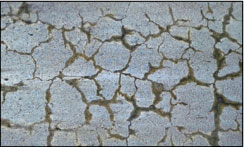 The chemical reaction is extremely complex. In simple terms, the cement paste can attack the siliceous aggregate converting the poorly crystallized or amorphous silica to a soluble alkali silicate. This, in turn, expands and then coverts the gel to solid calcium silicate hydrate. This expansive pressure increases in the core of the aggregate. The accumulated pressure can result in cracks to the aggregate and the surrounding cement paste. The problem is known worldwide, and we in the stucco business should be paying attention. The terrazzo industry has noted the condition and taken steps to prevent this issue of ASR. Portland cement and quartz sand, the aggregate we use, are rarely a problem. ASR has become more noticeable when designers opted for “glass” aggregates over the more traditional marble chips. The industry now recommends to the designer to stay away from glass aggregate.
The chemical reaction is extremely complex. In simple terms, the cement paste can attack the siliceous aggregate converting the poorly crystallized or amorphous silica to a soluble alkali silicate. This, in turn, expands and then coverts the gel to solid calcium silicate hydrate. This expansive pressure increases in the core of the aggregate. The accumulated pressure can result in cracks to the aggregate and the surrounding cement paste. The problem is known worldwide, and we in the stucco business should be paying attention. The terrazzo industry has noted the condition and taken steps to prevent this issue of ASR. Portland cement and quartz sand, the aggregate we use, are rarely a problem. ASR has become more noticeable when designers opted for “glass” aggregates over the more traditional marble chips. The industry now recommends to the designer to stay away from glass aggregate.
Why is this important to us?
Silica dust exposure was, and still is, a concern to plastering. It might seem a logical next step to consider switching to a recycled glass as a substitute. Glass is made of sand and, essentially, also a silica. But this silica is chemically altered when it is turned to glass, making the dust not a crystalline silica. Since ground glass is not a crystalline silica, this could tempt some to replace this glass over traditional quartz sand, which is crystalline silica and falls under the OSHA rules. We should be careful about jumping to solutions without vetting all the ramifications.
SNAPSHOT OF THE ECONOMY
The FMI Third Quarter 2019 North American Engineering & Construction Outlook has released its report on the economy. This report features comprehensive construction forecasts for the U.S. and Canada as well as information on key market drivers. Contact the SMA office if you would like a copy of the FMI report.
Key highlights of the report include:
- Total engineering and construction spending for the U.S. is forecast to end up <1 percent in 2019, compared to up 3 percent in 2018.
- U.S. spending growth in 2019 is expected to be led by public investment across both nonresidential buildings and nonresidential structures. Current top-performing segments forecast in 2019 include conservation and development (+10 percent), water supply (+9 percent), public safety (+9 percent), transportation (+8 percent) and sewage and waste disposal (+8 percent).
- Only one U.S. segment was upgraded into our growth category through the second half of 2019, lodging. On the other hand, the commercial market was the only segment downgraded, from stable to down. Despite stable fundamentals, all three residential segments continue to show weakness and are expected to end this year below 2018 spending levels.
- FMI’s Nonresidential Construction Index (NRCI) at 50.4 is the lowest score recorded in more than seven years. An index score over 50 suggests improving or expanding industry conditions.
- Several of Canada’s segments, including conservation and development, power, public safety, sewage and waste disposal, and water supply, were upgraded into our growth category through the second half of 2019. In contrast, the lodging and office segments were downgraded from growth to down.
US CENSUS DATA: Privately owned housing starts in September 2019 were at a seasonally adjusted annual rate of 1,256,000. This is 9.4 percent (+/- 9.4%) * below the revised August 2019 estimate of 1,386,000.
Snapshot on US Housing Starts :
- September 2019: -9.4* % change
- August 2019 (r): +15.1 % change
ASTM NEWS
 ASTM C 1861 is the new ASTM that pulled trim accessories out of the old ASTM C 1063. This ASTM goes into detail on the specifications for the trims used in cement plaster. Several pages are dedicated to illustrations of trims used in plastering and a name assigned to each trim. Table 3 covers the Fasteners and the length required to attach the various trims to framing members. Table 1 covers minimum thickness required for the trim accessory. Table 2 is for Cold-rolled Channel Furring.
ASTM C 1861 is the new ASTM that pulled trim accessories out of the old ASTM C 1063. This ASTM goes into detail on the specifications for the trims used in cement plaster. Several pages are dedicated to illustrations of trims used in plastering and a name assigned to each trim. Table 3 covers the Fasteners and the length required to attach the various trims to framing members. Table 1 covers minimum thickness required for the trim accessory. Table 2 is for Cold-rolled Channel Furring.
ASTM C 1860 is also new. For decades there was no test to verify the bond of cement plaster to masonry or to itself. ASTM C 1860 addresses this. This is a test method with procedures to determine the tensile strength of Portland cement-based plaster. The test is appropriate for new and existing construction if the plaster has been in place a minimum of 28 days. This is a bonding test and not intend to evaluate the underlying construction or framing the test methods are intended to be used as a tool to quantitatively evaluate the existing Portland cement plaster cladding that is suspected of questionable bond or uncertain fastening to the substrate. Test method A and B are essentially cut squares where the stucco is pulled off the wall. The SMA is still evaluating the value and how it will ultimately impact the stucco industry. This may be more about how it is used, by whom and for what purpose.
PLEASE NOTE: SMA OFFICE CONTACT INFORMATION
Mark Fowler, Executive Director
Marlene Lampert, Office Manager
Stucco Manufacturers Association
5753 E Santa Ana Cyn Rd, Suite G-156
Anaheim, CA 92807
Office: 714-473-9579
Mark@stuccomfgassoc.com
Marlene@stuccomfgassoc.com
REMEMBER: The SMA has a fairly large library on all things stucco. Members of the SMA are encouraged to call the SMA office if the staff can be of any assistance.
Summer 2019 eNews
MESSAGE FROM THE SMA EXECUTIVE DIRECTOR

Mark Fowler, SMA Executive Director
Hope everyone is looking forward to a great summer. The SMA has a lot happening. We have released the 2019 Stucco Market Report. The first industry report was in 2016 and was used extensively around the United States. The report gained respect as accurate and insightful, as being specific and targeted to our industry. The SMA was invited to the World of Concrete to demonstrate STUCCO LIVE in large part due to the 2016 Stucco Market Report. The 2019 updated version will continue this trend as it is based on data from the US Census Bureau and other market research groups. The SMA takes that data and combines it with our knowledge and can make several observations. The report is a free download at the SMA website.
We know designers and building owners have a selection when deciding which siding for their project. We should be aware that while fire-ratings, egress and ventilation issues are not optional, the choice to use stucco certainly is. We need to keep stucco in front of them along with the fact it is the best option for a long and low maintenance life as a cladding. Stucco has a strong history of proven success. However, just a few failures have been highlighted by bad actors and some of our competitors. Some simply want stucco to just go away. They know that head to head in a fair comparison, stucco wins out. Even ASTM says so. The Cladding Life Cycle study of 1996 put cement stucco on top when compared to others (see Table 1 & 3). The US Department of Energy released two reports on hard coat stucco in 2018. One discussed one coat stucco over foam and highlighted the energy benefits. The other was a cradle-to-grave study on how stucco impacts the environment with regard to a carbon footprint. The study compared both three coat and one coat stucco. The report states, “properly done, a cement stucco should provide a useful service life of 100 years.” All this is good news and explains why other claddings try so hard to bring us down. One of our competitors has gone to the length to offer free stucco inspections. Not surprisingly, they recommend removing the stucco and replacing it with their cladding every time.
While it seems stucco will always win, that would not be an accurate picture of our market. We need to promote our industry. We need to work together to keep stucco on the minds of the designers and provide assurance that the stucco will function as promised—a long time with low maintenance. Your SMA board is on that task.
Always feel free to call the SMA for any assistance we can offer to our members.
Education/Training
We know cement stucco is the best cladding, but it has to be done correctly. We also know that it can be a real problem when installed with significant errors. But how can owners tell if the stucco is being done so it will function properly? Most experts will agree that simply adhering to ASTM is not enough and certainly no warranty. Are the materials selected correct and mixed properly? Is the installer trained and educated on stucco? It is these factors that overwhelmingly determine if stucco will function as intended.
It starts with an understanding of how stucco manages moisture. Knowledge must not be based on rumors, myths or driven by the need to make sales. The method to manage moisture can vary dramatically depending on the substrate. Masonry is not the same as framed walls as direct applied systems are not rainscreen. Stucco is versatile and can be adapted to a variety of methods when dealing with moisture. This is why stucco is more complex and can be challenging. The fact is that stucco done well will be the lowest cost cladding. Table 3 is from an ASTM study on claddings and verifies that stucco provides the lowest net life cycle cost.

SMA ON-LINE EDUCATION IS COMING
Designers and developers need to know they have hired trained and educated installers familiar with stucco. It is a must for a successful stucco installation. While apprenticeship is certainly the best method to develop an educated work force, the process can be expensive, slow and typically only can reach a small percentage of the total work force.
The SMA is working on an online education program consisting of seven training modules for installers. This can reach a wide group and do it fast. On-line training is proven to work on educating and keeping costs low. While most stucco performs intended, simple mistakes can be catastrophic. The SMA education committee believes these mistakes could be remedied if the installer simply understood the basics tenets of a hard coat stucco installation with regard to moisture. The program will put a focus on flashing and moisture to solve the more serious problems. The program also adds training tips from experienced plasterers on techniques, such as how to use the straight edge, improve hand tool production and other techniques that the older plasterers have known for decades.
On-line training may lack a hands-on component, but education is critical. The SMA contractors will be able to use the program to enhance their On-The-Job (OJT) training of all workers. On-line training offers advantages of allowing sponsoring contractors, lathers and plasterers to learn at their own time and a pace that works best for them. The education modules are put together by experts in architecture, building codes and plastering. The program will include tips on machine pumping of plaster to improve productivity. This is not a sales program, but real training, generic and comprehensive. The modules cover basics of moisture management, pros and cons of one and three coat stucco, basics in flashing, water-resistant barrier and lath installations. It also covers how to use alternates to the code.
It is important to reach young installers to start them on the right track and not let bad habits ruin our industry. The goal is pretty simple: restore faith in stucco to developers and designers in the regions of the country who have concerns about hard coat stucco. Passing exams and holding certification cards will provide assurance that stucco will last and be low maintenance. The modules will be in English and Spanish. A rigorous test must be passed to receive a certificate of completion and/or wallet card. Cost has not been determined, but be assured it will be very low.
One module will focus on supervisors for lathing and plastering. They will gain a comprehensive education on building science, codes, standards, windows, design pressure and avoiding litigation issues related to stucco. The module will cover record keeping to protect yourself in the event of litigation issues. This will make them better supervisors to the employers.
The final module that completes the circle of a successful, serviceable and sustainable stucco—the extra set of eyes. This is the third-party inspector. This module will be available to developers, designers and inspectors, but only true third-party inspectors will receive a certificate and be listed on the SMA website to inspect hard coat stucco installations. This module will include system identification, a short checklist and a review of basic details.
The benefits of the program are:
- Regain the trust of the designers, developers and public
- Contractors having better educated and productive crews
- Manufacturers expand the stucco market
- Building owners get better and cost affordable stucco
- Less litigation and support on frivolous claims
SAVE THESE DATES
Mark your calendars now to SAVE THE DATE for upcoming SMA events:
- September 23: SMA’s Annual Golf Tournament
- November 6: SMA Membership Meeting
- February 4-7 , 2020: SMA presents STUCCO LIVE! at the World of Concrete in Las Vegas
US STUCCO MARKET STUDY for 2019
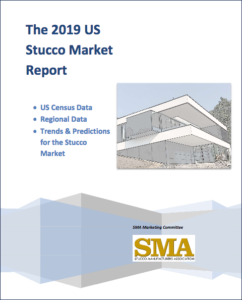 If you are curious about how the stucco market is doing, look no further than the SMA’s second report on the size of the stucco market. The data is based on statistics gathered by the US government. The report is a free download on the SMA website. The executive summary: three of four markets saw stucco lose market share. One market saw an increase. More amazing was that the one market segment where stucco market share grew, it took it from the fact fiber cement siding market. The industry could use this as a model on how to win back market share. The report also reveals other claddings that seem to mesh well with stucco. The SMA plans to stay on market share analysis and keep our members informed.
If you are curious about how the stucco market is doing, look no further than the SMA’s second report on the size of the stucco market. The data is based on statistics gathered by the US government. The report is a free download on the SMA website. The executive summary: three of four markets saw stucco lose market share. One market saw an increase. More amazing was that the one market segment where stucco market share grew, it took it from the fact fiber cement siding market. The industry could use this as a model on how to win back market share. The report also reveals other claddings that seem to mesh well with stucco. The SMA plans to stay on market share analysis and keep our members informed.
Feature Articles
STUCCO & WINDOWS
Few issues create as much controversy as how cement stucco should be terminated to a window. While many support the regional practice of every window having a casing bead and sealant joint around the entire window, some believe stucco may abut the window frame. Is this allowable, is it a defect? Contractors that support this practice have been successful in litigation defending this practice, and it can pass water tests. So which side is right? This depends on a few factors. How can we draw lines as to when and where this can be done?
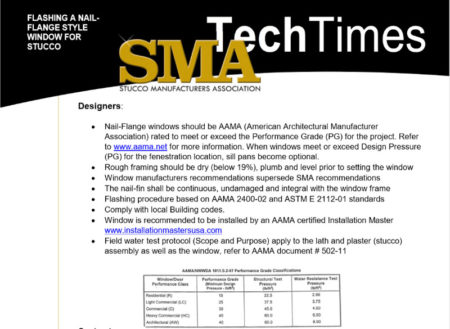 The SMA has published a technical paper that can explain why, when and where. It also provides requirements, most are by others to comply with so you can be allowed to install the stucco to abut the window. Owners like the no maintenance of no sealant joints, but there are caveats. This paper was reviewed and approved by experts in codes, windows, and litigation. It should be noted that just because you have always done it that way is not a viable defense.
The SMA has published a technical paper that can explain why, when and where. It also provides requirements, most are by others to comply with so you can be allowed to install the stucco to abut the window. Owners like the no maintenance of no sealant joints, but there are caveats. This paper was reviewed and approved by experts in codes, windows, and litigation. It should be noted that just because you have always done it that way is not a viable defense.
It is important to understand that both sides of the argument make valid points. If we can accept that codes today are more performance based than ever before, designers will then have more options. The options are based on performance requirements as established by the code. Most notable is the “Components and Claddings” section of the code. This section provides guidance on selecting materials, products and design options. While contractors prefer following a regional or state regulated procedure, that practice may not meet the performance directive set by the code. It also may be adding unneeded costs. Understanding the process might help explain:
STEP ONE: The designer of record is charged to meet ASCE design requirements for Components and Claddings. This includes wind and negative pressure. Not by accident, AAMA (American Architectural Manufacturers Association) has Performance Class ratings for windows to fit and meet the Design Pressures established by ASCE.
In simple terms, an opening for window in Miami is not the same as the opening for a window in Phoenix or even central Florida. The AAMA Performance Class addresses this. Formulas rate the opening and then AAMA tests and rates the window. The two should match up, and when installed correctly, leaks will be avoided. The Stucco industry through a technical bulletin has used this same formula to establish which AAMA rated windows can have stucco directly abut the frame.
This should help provide some guidance and support on what can and cannot be done, or more accurately what can and cannot be defended in court. A final caveat is that the designer of record and window manufacturer supersedes SMA recommendations. In addition, contractors are free to institute their own “in-house” policies.
THE STRAIGHT EDGE
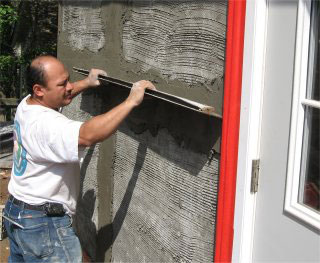 The straight edge, featheredge or rod is made of magnesium and used by plasterers to cut angles and make walls flat. Most industry experts agree the allowable tolerance of ¼ inch in an 8 to 10 feet run is the industry practice for quality work. While some feel this is inadequate, holding to this tolerance will produce an aesthetically pleasing wall. Very few people can discern ¼ inch in eight feet is out of plane. Tolerances stricter than this are possible, but considered unreasonable without clear direction and adequate compensation. The method of plastering alters when tolerances are required to be stricter than ¼ inch in eight feet. Most plasterers have not been trained to use the “dot and screed method.” The process is basically applying daubs of plaster or set blocks spaced within a six-foot spacing. The dots are set plumb using a string line. These will be allowed to set. Then the plasterer uses these dots or guides to fill and rod the plaster. It is similar to how tile setters “float” the mortar bed. Establish a plumb line and work from that using the rod as a screed. Coincidentally, plasterers use the term float as well, but it means something entirely different. While all this sounds basic and simple, it is time consuming. Tolerances tighter than ¼ inch in ten feet are possible, though owners should be prepared to pay extra cost for the labor required. This can vary from complexity, size and skill of the plasterers. The dot and screed plaster technique is not common, and no one should be expected to bid to these tolerances without clearly being notified this is expected. A simple and basic stucco specification and referencing a tighter tolerance should be noted by the plastering contractor and clarified. However, it should not be a tool or hammer to leverage the contractor into unfair and unjust conditions. Expecting tighter tolerances will cost more and low bids must be excluded.
The straight edge, featheredge or rod is made of magnesium and used by plasterers to cut angles and make walls flat. Most industry experts agree the allowable tolerance of ¼ inch in an 8 to 10 feet run is the industry practice for quality work. While some feel this is inadequate, holding to this tolerance will produce an aesthetically pleasing wall. Very few people can discern ¼ inch in eight feet is out of plane. Tolerances stricter than this are possible, but considered unreasonable without clear direction and adequate compensation. The method of plastering alters when tolerances are required to be stricter than ¼ inch in eight feet. Most plasterers have not been trained to use the “dot and screed method.” The process is basically applying daubs of plaster or set blocks spaced within a six-foot spacing. The dots are set plumb using a string line. These will be allowed to set. Then the plasterer uses these dots or guides to fill and rod the plaster. It is similar to how tile setters “float” the mortar bed. Establish a plumb line and work from that using the rod as a screed. Coincidentally, plasterers use the term float as well, but it means something entirely different. While all this sounds basic and simple, it is time consuming. Tolerances tighter than ¼ inch in ten feet are possible, though owners should be prepared to pay extra cost for the labor required. This can vary from complexity, size and skill of the plasterers. The dot and screed plaster technique is not common, and no one should be expected to bid to these tolerances without clearly being notified this is expected. A simple and basic stucco specification and referencing a tighter tolerance should be noted by the plastering contractor and clarified. However, it should not be a tool or hammer to leverage the contractor into unfair and unjust conditions. Expecting tighter tolerances will cost more and low bids must be excluded.
CLOSE SHAVE
Shaving the wall with the featheredge or rod is another plastering technique used on brown coat application. ASTM refers to it as “dry rodding.” The idea is to remove high spots or humps in the basecoat of plaster. This is not a dot and screed method, but simply good and common plastering. Too often the plasterer goes the semi-set basecoat and starts shaving the wall by sight alone.
They should check the wall for flatness prior to starting to shave the plaster. The checking procedure should include vertical and horizontal checks. This means checking the wall in both directions. This is the only way to truly know where and if shaving with the rod is even needed. Unnecessary shaving wastes time, money, material and leaves the wall thinner than it should be. Thinner walls are more susceptible to water penetration and cracking. To add insult to injury, the contractor must also now pay another person to have the cement droppings removed. Be smart, check that wall before you shave.
PLEASE NOTE: SMA OFFICE CONTACT INFORMATION
Mark Fowler, Executive Director
Marlene Lampert, Office Manager
Stucco Manufacturers Association
5753 E Santa Ana Cyn Rd, Suite G-156
Anaheim, CA 92807
Office: 213 379 5890
Mark@stuccomfgassoc.com
Marlene@stuccomfgassoc.com
REMEMBER: The SMA has a fairly large library on all things stucco. Members of the SMA are encouraged to call the SMA office if the staff can be of any assistance.
Winter 2019 eNews
MESSAGE FROM THE SMA EXECUTIVE DIRECTOR

Mark Fowler, SMA Executive Director
2018 was a big year for the SMA, and 2019 promises to be even bigger. We finalized our Silica Compliance Program and signed up contractors from all over the United States. The SMA provided many with Competent Person training and cards to verify training and even made training available online to members. We have continued to test and improve our engineering controls to better protect workers and ensure employers are in compliance. The SMA has also worked closely with OSHA and CALOSHA on the written exposure plan. We have provided SMA test data from air monitoring with both agencies as industry Objective Data. We will continue to work with OSHA to better protect our most valuable asset, your workers.
The SMA Board of Directors has always been thought of as a California group. Today, though, we have directors from all corners of the United States serving on the SMA board. This makes the SMA more well rounded and a better voice for the state of the stucco industry across the entire United States.
Apprenticeship is a concern for all contractors, and even more so for the skill-intensive trades. Lathing and plaster would certainly qualify as skill intensive. The Department of Labor recognizes that this industry is hurting with regard to training. However, they noted the industry is too segmented or regionalized to select one or the other group to expend efforts with. The SMA has made great strides in unifying the states and it has not gone unnoticed by the Department of Labor. Their 2018 funding for education went to other groups as the SMA was not and is still not quite there to stake a legitimate claim for funding to train lathers and plasterers. However, recent efforts by board members in Texas and Florida have helped gain the attention of Washington D.C. Hopefully in 2019, we can secure a formal training program with some form of certification to designers and building owners.
STUCCO LIVE 2019: Recap from the World of Concrete, Las Vegas
The SMA hosted the STUCCO LIVE event at the World of Concrete show that was held in January at the Las Vegas Convention Center. For four days the SMA booth and STUCCO LIVE stage area was very busy. Crowds intensified during the live presentations of lath and applications of plastering. The Operative Plasterers and Cement Masons Associations (OPCMIA) was instrumental in making the show a huge success. The popularity of the live exhibits was proof that stucco is desired and market share for stucco has room to grow. We need to keep stucco promotion going.
Thanks also go out to our SMA member sponsors. Their contributions were not just a financial help – we had many SMA members working the floor of STUCCO LIVE. They provided expert advice to attendees with questions on water-resistive barriers, lath, cement and acrylic plasters.
Thank you SMA members and sponsors:
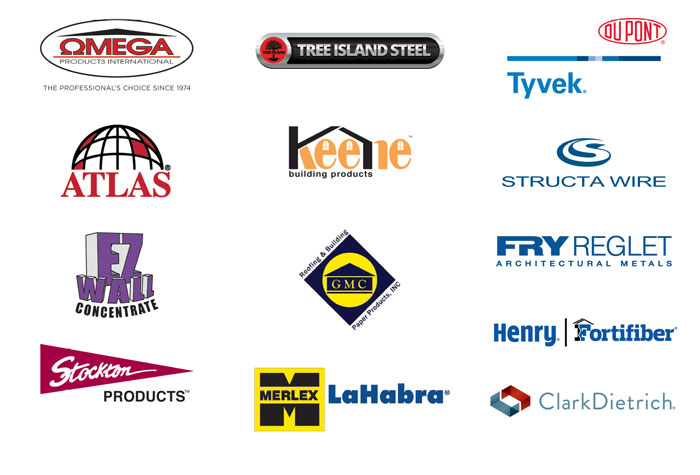
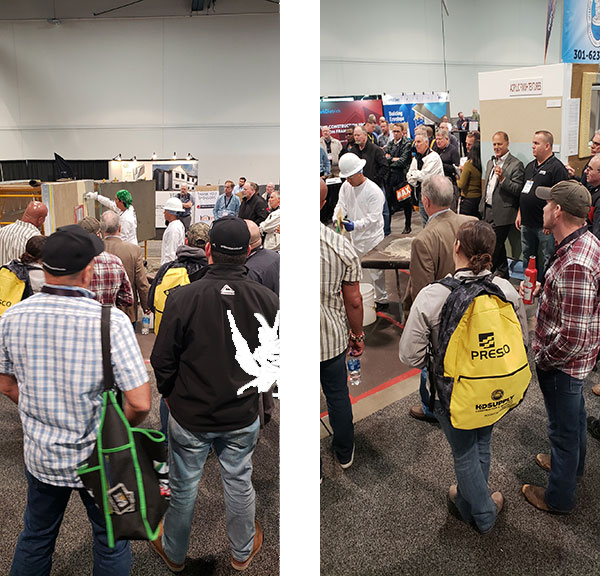
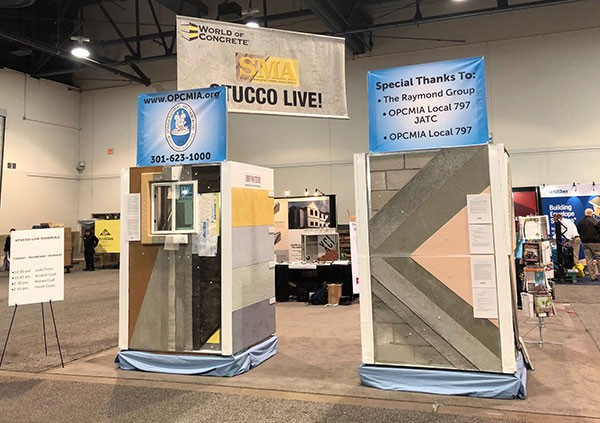
INDUSTRY UPDATE
The stucco industry is estimated to be a $2 billion a year industry per the US Census Bureau. This can change: the cement stucco market can grow, or it can shrink. This depends largely on the actions of us as a united industry. Make no mistake that other claddings want more market share, and they have instituted strategic plans to grab stucco market share. One major cladding has gone as far as offering free inspections for stucco buildings that result in recommended removal and replacement with their products. All industries need to be guided. While fighting for your company’s share of the market is understandable and needed, so too is a collective plan to grow overall market share. After all, a greater percentage of a shrinking market is still a shrinking number.
The good news is that cement stucco is one of the best claddings on the market. The US Department of Energy has recently released a report on the life costing and life span for cement plaster on buildings and news is very good. But only a concerted effort and strategically supported marketing plan can ensure the word gets out to the public. There is much work to be done and resources are needed to ensure our market does not vanish.
The masonry industry suffered substantial loses in market share a few decades ago, but they then invested in the industry, developed a long-term plan that included industry promotion, education, free technical services to the design community and litigation support. That investment has yielded results. The stucco industry should take a similar path.
ASTM STANDARDS
ASTM standards are constantly changing. ASTM conducts two committee weeks each year, filled with meetings to discuss changes. In addition to these semiannual meetings, most committees have conference calls monthly to discuss revisions to standards.
The process is not simple by any means. Proposed revisions are discussed during work group meetings, sent out to ballot, and voted on by voting members. If it passes the ballot, it is sent to a higher committee that may approve or reject it. If it is approved, it is written into the standard the next year.
I attended Committee Week in November of 2018 and I was surprised with what I experienced. There were some manufacturers, but not as many as to be expected. There were even fewer contractors. The majority of those present were engineers, architects, and third-party inspectors. These inspectors earn a living in most cases by offering observations and litigation support, many times on the side of the plaintiff. Not all of them are bad, and I felt a few of them have good intentions for our industry. Others clearly have an agenda to keep certain parts of the standard intact, so they have a way to make a decent application appear to be insufficient. This is how they make their money, and cause problems for our manufacturers, contractors, and industry.
These are not the people who should be making the rules regarding how our work is done. Many of them have never held a tool. They simply know how to work the system, find a small error in an application, and make the contractor pay to fix it; regardless of the actual cause, related or not.
It costs $75 and a little bit of time each year to join ASTM and become a voting member. You also receive a copy of the standards book for the year. This is cheaper than buying just one standard online. I encourage everyone involved in our industry to join and participate. The only way to keep up with the standards and have a say in changes made is to join and vote. If you do decide to join, ask to be added to the C11 Committee and any other committees that pertain to work you perform. C11 also has a stucco work group that meets every month to discuss revisions. It would show we care about our livelihood if we had more participation from contractors and manufacturers. If you have any questions or need assistance joining any of these groups, please contact me directly.
Rick Durham, General Manager – EZ Wall Concentrate
214.859.2120 – rdurham@ezconcentrate.com
SMA MEMBERSHIP MEETING
On February 27th, the SMA member meeting will cover the “State of the Industry.” This is more relevant than ever before as news from one corner of the country travels fast and impacts all regions. In addition, the SMA board of directors now has the widest reach across our nation like never before. Join us to learn what is in store, trends that are happening under our nose and then work with us as a team to secure the future of stucco. Sign up today.
SAVE THESE DATES
Mark your calendars now to SAVE THE DATE for upcoming SMA events:
- May 22: Membership Meeting
- September 23: Annual Golf Tournament
- November 6: Membership Meeting
Feature Articles
THE NAIL-FLANGE WINDOW
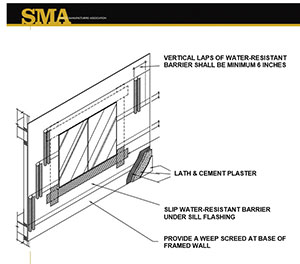
This type of window is well suited for cement stucco. The nailing flange is used to support and attach the window. A proper flange can also allow for flashing strips to be installed and integrated with the water-resistant barrier to shed incidental water down and out. This is compatible with the concealed barrier or rain screen moisture management options employed on stucco over framing wall assemblies. The SMA has published a guide for recommended procedures for flashing a nail-flange style window when used on framed walls that will receive cement plaster (stucco). While using a casing bead and sealant is never a bad idea, some prefer to abut the stucco directly to the window. This lowers maintenance issues and is often considered more aesthetically appealing. The SMA supports this practice with caveats. The full document explaining the SMA position is on the SMA website under Technical Resources.
Plastering contractors are advised to download the 4-page document, review the “performance” data and ask the developers if their project, windows and specifications allow for abutting stucco to the window frame. Only the SMA publishes a document that clearly allows this practice to be done. Contractors should be aware that not all projects, windows or regions of the country will meet the caveats. It is not your responsibility to design or select windows. The developer or designer of record should have all that information readily available. This procedure is simply to ensure they did their job, so you can do yours. Following this protocol will help eliminate leaks and protect you from litigation claims.
PAINTING STUCCO?
This is a question frequently asked by building owners. They rely on the SMA for an unbiased opinion. SMA members should know what we are saying. This article will try to cover many of the concerns and questions the SMA gets on painting or re-decorating cement stucco.
GENERAL: Cement stucco does not need to be painted. However, it can be painted if desired. In some parts on the country contractors use paint to seal cement stucco. If the cement is properly mixed and applied, it will be resistant to the passage of moisture. Good application of cement plaster requires the cement to be densified to consolidate the membrane. However, painting stucco does not have a negative impact on the cement. It is recommended to use paints made for cement that are alkali resistant. Acrylic finish stucco is not a cement product and using a good acrylic paint will allow a cost-effective color change. The following is for cement stucco finish.
Cracks: Hairline cracking is inherent in cement stucco and rarely a source of leaks. Generally patching narrow or tight cracks is not recommended. The patch can look worse than the hairline crack. Even after painting. Cracks that are larger and a concern should be investigated and patched by professionals. Elastomeric coatings can hide cracks [see Vapor Permeability].
Vapor Permeability: A cement plaster or stucco cladding was intended to breathe. This means to allow moisture as a vapor to pass through the cement. It therefore makes sense that the paint or coating should be vapor permeable, too. Acrylic paints are the most often used and they are vapor permeable. Elastomeric coatings go on thicker and have the ability to stretch. This makes them excellent at covering and hiding cracks. One concern is the lack of vapor permeability for elastomeric coatings. They keep water out, but they can also keep water in. Over time, vapor drive can push the coating and form bubbles or blisters. Before using an elastomeric coating on stucco, talk to local dealers and contractors to verify successes or failures in your region of the country.
Fog Coating: This is a cementitious paint made by stucco manufacturers to blend or even colors on integrally colored finish cement stucco. Generally not recommended to use for a color change. The product is dry cement, lime and pigments that are mixed with water. Application is done with a hand-held garden type sprayer. This is not a do-it-yourself operation – ask your plastering contractor for help.
PH level: Fresh cement will be high in alkalinity. It is common for cement stucco to be around 12 to 13 on a Ph level. The good news is that level tends to drop in the first few weeks. Painting fresh stucco should be held off until the Ph level is below 8.
Water Resistance: Integrally colored cement stucco finish will darken when wet. The color will return when the stucco dries out. Painted stucco has the advantage of not getting dark when wet. Acrylic finishes will act like painted cement stucco.
Color Selections: It should be noted that salts are always present in cement products. They can leech out when the sun heats up the wall to draw out the water that may contain salts. This is called efflorescence. Darker colors tend to not only show more efflorescence, they can allow the wall to heat up more and faster, making efflorescence appear more often.
Painting a Sand “FLOAT” Finish: This has been recent issue on many projects as designers want to return to natural cements and then paint the new stucco for color enhancement. What can happen is the owner will run their hand along the wall and note the cement plaster will appear to flake off. They become convinced the contractor did something wrong as the house next door that is 15 years old does not have this issue. Here is what is happening:
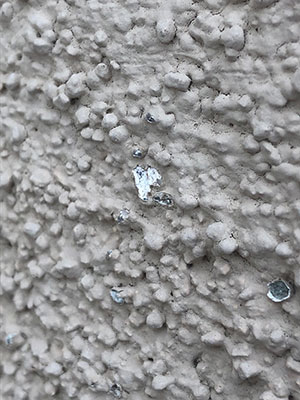
To obtain the float finish, the plasterer floats the wall with a wet sponge-type float. This is to bring the sand to the surface, making it look like a uniform sandpaper. This means that some grains of sand are only semi-buried in the cement paste. It can be particularly noticeable with more angular sands. Picture a triangle shaped grain of sand with only about 25% of the tip in the cement paste. The painter comes along and sprays the wall with paint. A few days later the owner touches the wall and those tiny grains that were just hanging on, break off. See picture.
In reality, the cement nor the paint coating is fully cured. Over time, they will both cure and become much more resistant to sand breaking off. This is not new but more of an issue as designers are moving away from larger sand (16/20) to more fine sand (20/30). The finer sand has more grains at the surface and therefore more exposure to the problem.
TIPS: If painting a new sand finish is to be done, a very soft brush can be run over the stucco prior to painting. This will help remove very loose sand. A painter can also back-roll after spraying to help dislodge loose particles. Even after this, it can and will occur. It is recommended to touch up the areas just prior to turning the building over and ask owners to be a little careful for a few months. Once the cement and paint both fully cure, this issue generally goes away.
Acrylic versus Cement Finish: Both are great products to use as final decoration on cement plaster. Acrylics tend to be much better on color and texture uniformity. They tend to require a better brown coat and primers are recommended. Colors can be a very wide range. Owners can pick from any paint color chart and your stucco manufacturer will match it. Most texture with acrylic finishes are sand or float finish as this is not their strong suit. They also do not have the sand issue flaking off issue that is more common with painting new cement stucco.
Cement finish stucco is lower cost and offers the widest range of textures. Even smooth trowel is done more with cement as the troweling action brings up what plasterers call “fat” to fill minor imperfections. Cement finish tends to show more hairline cracks. Very dark colors in cement are not generally advised with integrally colored cement finish stucco.
PLEASE NOTE: SMA OFFICE CONTACT INFORMATION
Mark Fowler, Executive Director
Marlene Lampert, Office Manager
Stucco Manufacturers Association
5753 E Santa Ana Cyn Rd, Suite G-156
Anaheim, CA 92807
Office: 213 379 5890
Mark@stuccomfgassoc.com
Marlene@stuccomfgassoc.com
REMEMBER: The SMA has a fairly large library on all things stucco. Members of the SMA are encouraged to call the SMA office if the staff can be of any assistance.
Fall 2018 eNews
MESSAGE FROM THE SMA EXECUTIVE DIRECTOR

Mark Fowler, SMA Executive Director
The SMA has been busy and been invited to present in Texas and Florida. There is a definite vibe in the lath and plastering industry that change is needed. At one time there were many associations and bureaus dedicated to promoting lath, plaster and stucco. These groups used technical excellence and promotional plans targeted to promote the more expensive and superior finish materials in the plaster family. Today only a handful are left, and most have become more focused on drywall — and even gone as far as shifting promotional efforts more toward metal or other paneled exteriors.
Lath & plaster is not the lowest cost or simplest installation for the construction industry. While cement stucco is considered a staple in the southwest, it is a premium in most regions of the country. Significant loss of stucco marketshare in California or Arizona seems unlikely to occur. However, we should not forget that 40 years ago, tract homes being built by non-union labor was inconceivable to us in the industry, but that did come to pass.
The point is that plastering needs promotion. Consider that drywall ads are run in current architect magazines and we see none for plastering. Maybe the lath & plaster industry should take a cue from the same industry that kicked them to the curb only a few decades ago. Taking a market for granted is one of the most common errors an industry can make until it is too late. The good news is that designers and building owners want plaster. The SMA knows this to be true as we receive phone calls and emails requesting help with design, details and product selection on a daily basis.
As other associations shift their focus away from lath and plaster to drywall and exterior panels, the design and even code enforcement entities have fewer and fewer resources for help. The SMA is not funded through a collective bargaining agreement that creates an unstoppable and continuous source of revenue. Marketing is not by accident; it requires planning and funding. The alternative is a slow demise in market share. It is our collective duty to find ways to deliver lath & plaster to the end users at a reasonable cost and then ensure they want it again on the next project. The simple translation is to service the designers with credible expert advice, supply a skilled work force, and assure quality–all for an affordable cost to building owners. The good news is that the vast majority of designers expect to pay a slight premium for lath, plaster and even quality stucco. Recent stories out of the East and Gulf Coast suggest that trouble is brewing for the entire plastering industry. Ironically, it appears the time we might need those old plaster bureaus the most is when they are systematically being destroyed.
Much of the lath & plaster industry is aware of a crisis, and making moves to save plastering is being discussed. This includes groups like the Texas Lath & Plastering Contractors Association, the National One Coat Stucco Manufacturers Association and the Florida Lath & Plaster Bureau. Each has met with the SMA and shared their concerns that cement stucco is under attack. The agreed plan is to address the first need: what can be done to ensure plastering and stucco will continue for the next generation?
A major concern is the claim about water leaks. While some are real issues, others are tests being manipulated to force leaks, substantiate frivolous claims and secure insurance funds. The SMA has two goals:
- Help those building owners who have had bad stucco installed that resulted in leaks.
- Help those contractors who have installed functional stucco and are being hit with frivolous law suits.
Lath & plaster is skill intensive and requires that unique blend of craft, science and experience to ensure it functions as it has for over 200 years in the United States. We all want cement stucco installed per ASTM and the best practices. We know that most projects are not installed per ASTM literature and that the vast majority of stucco installations are functioning as intended. One issue is that ASTM has problems with allowing regional differences and alternative practices. The SMA recognizes that there are regional practices that alternates should be allowed. The few stucco jobs that are failing are generally the result of poor practices or a failure to ensure the completed assembly is functional as it was designed. We can and must do a better job if we want to keep lath & plaster relevant. This requires a concerted effort, coordination and some funding to help lathing and the art of plastering. It is only your future at stake.
STUCCO LIVE 2019: January 22-25
INFORMA has contacted the SMA to host “Stucco Live” at the 2019 World of Concrete show, January 22-25 at the Las Vegas Convention Center. The World of Concrete is one of the largest construction trade shows in the world. INFORMA discovered that 20% of attendees are interested to learn and see more on cement stucco. The SMA was a natural fit.
The South Hall will have a section dedicated to live cement plastering demonstrations and an SMA booth shared with the Portland Cement Association. We will have educational classes, product information and experts on staff to answer questions. This promises to be a great promotion to designers, contractors and dealers interested in cement stucco. There will be promotional opportunities and space is limited. SMA members will be given the first right of refusal to display goods and services. If interested, you should contact the SMA before we offer space to the general industry.
SILICA UPDATE
The OSHA ruling has been in place for one full year. At the six-month mark, OSHA announced they had issued over 117 citations for non-compliance to the ruling. They further announced that they will be ramping up citations in year two. Most citations were labeled as “serious.” The three most common violations were:
- Failing to have a written Silica Exposure Plan: All employers must have a written plan and it should be specific to the tasks the employees perform.
- No test data: OSHA inspectors are charged to verify the employers have tested the tasks employees perform with respect to silica exposure.
- Failing to follow the written plan: The written plan will include Table One and states what employees must do to avoid silica dust.
To date, there are records of plastering firms cited for silica dust violations. None were SMA members. SMA has been working with various OSHA offices and will continue to improve our members’ written plan to protect your workers and assure compliance to OSHA.
OSHA has also announced plans to expand Table One. This means that new tasks will likely be added. The SMA has also continued testing silica as it relates to mixing mortar and will be updating the written exposure control plan for SMA members to use as required by OSHA updates before the end of the year.
SMA contractor members may also request online “Competent Person” training. Contact the SMA to arrange for your foreman to receive their important training. [Click here if you need additional information about the SMA’s Silica Compliance Program.]
SMA GOLF TOURNAMENT
On September 24, the Annual SMA Golf Tournament was again held with the biggest turnout to date. Members enjoyed perfect weather, a private country club, and food that included a carving station and a taco bar lunch.

The raffle garnered some of the most excitement of the day. Prizes included high-end sipping tequilas, a Playstation 4, gift cards for dinners, Fitbit, even a large 4K television. Many commented that the SMA has the most impressive raffle prizes of any tournament. We can thank our great sponsors for their generosity that allows the SMA to supply such an impressive list of prizes. We are certain next year will again be a banner year.
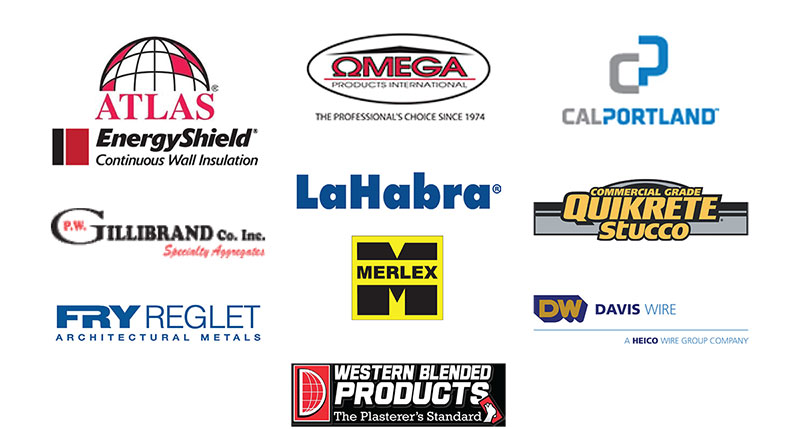
SMA MEMBERSHIP MEETING
The SMA November 7 meeting will feature an expert on the construction economy with a strong focus on housing issues. Sign up online today.
Feature Articles
HOW LONG WILL STUCCO LAST?
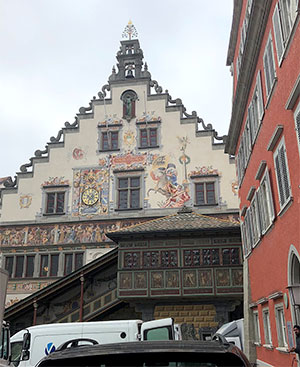 There have been groups that try to determine the life expectancy of various claddings. The US Department of Energy through the BEES (Building for Environmental and Economical Sustainability) will be adding to their software programs updated information regarding cement stucco as an exterior cladding. The report states “A properly installed stucco exterior will have a useful life of 100 years.” This powerful statement from the US Government was the result of data collected through exhaustive research and can be used by designers and insurance companies. There are countless framed structures in the United States that are 100 years old and clad in cement stucco.
There have been groups that try to determine the life expectancy of various claddings. The US Department of Energy through the BEES (Building for Environmental and Economical Sustainability) will be adding to their software programs updated information regarding cement stucco as an exterior cladding. The report states “A properly installed stucco exterior will have a useful life of 100 years.” This powerful statement from the US Government was the result of data collected through exhaustive research and can be used by designers and insurance companies. There are countless framed structures in the United States that are 100 years old and clad in cement stucco.
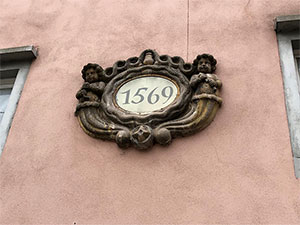 Ironically, 100 years is almost laughable to those in Europe. They have used stucco for centuries with a very long history of success. If you get the chance to travel old central European cities, you will note that many of these structures display the year they were built and subsequent renovations. Unlike the new world of America, renovations are not every decade, but typically about once every one hundred years.
Ironically, 100 years is almost laughable to those in Europe. They have used stucco for centuries with a very long history of success. If you get the chance to travel old central European cities, you will note that many of these structures display the year they were built and subsequent renovations. Unlike the new world of America, renovations are not every decade, but typically about once every one hundred years.
 It is not uncommon to see buildings painted elaborately to highlight how old they really are. For an American, we have to realize that many of these structures pre-date US history. Cement stucco has been the unquestionable cladding of choice for most of Europe. The weather-resistance, aesthetics and proven durability continue to make stucco the cladding of choice in Europe. In speaking with locals, they have seen an increase in other panelized claddings and note that they will not last like stucco and must account for the shorter life span.
It is not uncommon to see buildings painted elaborately to highlight how old they really are. For an American, we have to realize that many of these structures pre-date US history. Cement stucco has been the unquestionable cladding of choice for most of Europe. The weather-resistance, aesthetics and proven durability continue to make stucco the cladding of choice in Europe. In speaking with locals, they have seen an increase in other panelized claddings and note that they will not last like stucco and must account for the shorter life span.
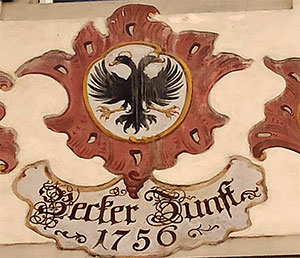 The collection of the dates on various buildings in Germany should prove that cement stucco can and will last a very long time indeed. Even over framing the force of the United States Government proclaims cement stucco will last 100 years. The SMA is in agreement, and the key is to have stucco “properly” installed. Properly means that cement stucco must function and two major factors addressed:
The collection of the dates on various buildings in Germany should prove that cement stucco can and will last a very long time indeed. Even over framing the force of the United States Government proclaims cement stucco will last 100 years. The SMA is in agreement, and the key is to have stucco “properly” installed. Properly means that cement stucco must function and two major factors addressed:
- Stucco must act as a weather barrier: This means good product selection that is mixed and applied to resist climate and water penetration. Cracking is minimized and protection increased. It is not impossible or even expensive to make this happen. The Europeans have been doing it for centuries.
- Stucco must be flashed: If the cement stucco works as a weather and water-resistant cladding per item #1, it makes sense that flashing is critical at termination and penetrations subject to water entry. Water entry must be controlled to allow only “incidental” moisture intrusion. This also includes penetrations, like windows, that are properly rated to keep water out. Again, Europe has been doing this for a very long time. In fact, their windows are in general superior in many ways to the new world windows we use. They expect windows to last a hundred years until the next renovation.
While the list for an inspection of lath and plaster could be long and detailed, it is predominately these two items that will make it work or fail.
THREE THINGS THAT MUST CHANGE IN STUCCO
Cement stucco is historic and unique as noted. The lather and plasterer must know what will and will not cause issues. They must know materials and how to blend them correctly. They must install lath and stucco to look good and function as the owner expects it to. While some believe following ASTM, the Code or some publication is the key to success, the truth is cement stucco is somewhat forgiving. This explains why it has worked for decades, or even centuries in Europe.
Experts have seen stucco installed in ways that make them scratch their heads and wonder how did that not fail? Perfection is unobtainable and even the old timers in the stucco industry did things that were not exactly per ASTM, but the stucco worked. A future article should be the noted failures to follow ASTM standards in Europe, yet the stucco still works. This is not meant to provide an excuse for not following ASTM or the code, but it does prove that trade skill and knowledge is still the best assurance for a successful stucco cladding.
Issues arise when skills/knowledge diminish in concert with downward pressure on pricing. This is especially true in price-sensitive markets where saving a few dollars can make or break the plastering contractor. However, there is always a point where cutting corners can result in failure. The following three items are considered paramount by most experienced stucco experts. All three are noted in ASTM in some form or another. To stave off issues, it is important the lath and plastering contractor understands and can overcome these three obstacles to functional stucco.
-
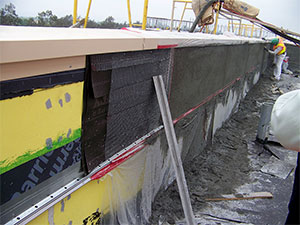
The tan metal cap flashing leg is reverse lapped to the building paper under the lath. Water may be directed into the structure. A simple oversight may result in big problems. REVERSE LAPS: We install shingles on the roof from the bottom up to meet the “ Shingle-Effect.” Yet, on walls we seem to lose sight of that concept. Water drains down. Lower layers must be lapped by the upper layers. This concept extends to integrated flashings as well. It is not uncommon for a wall leak to be traced back to a reverse lap. Since only incidental water should find its way behind the cement stucco membrane, most water will be absorbed into the cement and harmlessly exit as a vapor to the exterior. However, on occasion, more than incidental water may get in, weep or drain down, and the “reverse lap” is the path into the wall cavity. Even with a rain screen design, any reverse lap is a potential death sentence.
-
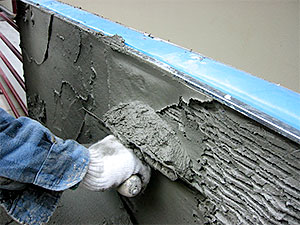
Trowel application allows for better encapsulation of the lath than a tool known as the slicker. THE SLICKER: This is a tool that has been around a long time. It has been called by many names across the country: Go Devil, Cheater or Shahalee are but a few. Using the slicker to smooth the cement plaster is not an issue. It is when it is used to apply the cement to lath that issues arise. The cement must be applied with sufficient force to embed and sustainably encase the lath. The Slicker is often used to scoop large amounts of cement from the mud board to the wall. The weight of the tool with cement makes it hard to physically force the cement in with the required pressure to fully embed and sufficiently encapsulate the lath. It is impossible to work a full day using this tool to embed the cement properly. The result is the lath on the back side of the cement is susceptible to premature rusting and failure. The situation is worse when using a metal lath. It is not a metal lath issue, but an application of cement issue. Cement should be applied with a hawk and trowel or a machine pump designed for plastering.
-
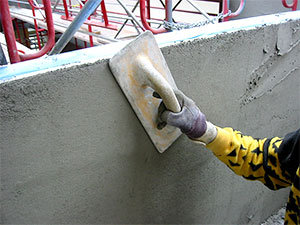
The floating process on the basecoat is to consolidate and densify the cement membrane. BASECOAT CONSOLIDATION: The cement membrane must resist water cracking and water penetration. This requires the cement basecoat to be floated with a wood, cork or other proper float. A sponge float lightly passed over the basecoat coat will bring out some sand and look very nice, but does not consolidate the basecoat. The result is more shrinkage cracking and less resistance to water penetration.
The proper materials, mix ratios and application are critical to a cement stucco that functions. Most plaster experts will agree, these three issues are far more critical than control joint placement, adding rainscreen or other red herring issues.
PLEASE NOTE: SMA OFFICE CONTACT INFORMATION
Mark Fowler, Executive Director
Marlene Lampert, Office Manager
Stucco Manufacturers Association
5753 E Santa Ana Cyn Rd, Suite G-156
Anaheim, CA 92807
Office: 213 379 5890
Mark@stuccomfgassoc.com
Marlene@stuccomfgassoc.com
REMEMBER: The SMA has a fairly large library on all things stucco. Members of the SMA are encouraged to call the SMA office if the staff can be of any assistance.
Summer 2018 eNews
MESSAGE FROM THE SMA EXECUTIVE DIRECTOR

Mark Fowler, SMA Executive Director
TAKE A VACATION: Summer is here, and I hope all SMA members take some well-deserved time off and enjoy a relaxing vacation. This should be a strong message to all owners and supervisors as well. Stress levels are increasing in everyone’s life. It is the sign of the times. The stress you feel today is more than you felt last year and much more than you had a decade ago. The forecast for next year is the stress level will likely increase again. This makes vacation time not just a nicety, but paramount. Talk to your employees. too.
Turn off the phone, leave the laptop at the house, and enjoy your family. De-stress and re-charge. Business owners have a really hard time doing this. It is hard to blame them, as they worked hard to build a successful company and often spend sleepless nights and fear things will go wrong while away. But you are of no value to family if you are dead. Maybe I’m being a bit too blunt, but stress is a killer — ask any cardiologist. So please, take some time to unwind and relax … if not for yourself, then for the ones who care and depend on you. TAKE CARE OF YOURSELF.
DO WE NEED CHANGE?
The SMA is growing in size — and influence. Just in the last year the SMA has helped several city inspectors, designers and many others in states across our great country. This is because lathing & plastering are skilled trades. They require knowledge of materials and the craft to properly advise and lead the industry. Simply quoting ASTM or handing out a checklist is inadequate for designers, inspectors or developers looking for qualified answers and they want third-party unbiased answers. Plastering is not drywall — and mistakes cannot be easily sanded away. Mistakes in stucco applications can lead to leaks, excessive cracking and potential litigation concerns. We seem to have forgotten our roots of plastering.
Blending semi-skilled trades with the more highly skilled crafts leads to an inevitable decline and dilution of the more skilled craft. This is because cost drives most everything, and developers typically select the lower cost options. This is evident by the loss of interior plaster to drywall. As drywall grew, interior lath & plaster became increasingly more irrelevant. When bundled in large trade groups, the majority wins and plasterers lose. This is actually fair and democratic. The more skilled craft, like lath and plaster, needs more training, education and attention: all this costs money. Since all big entities run on money, lath & plaster can look like a drain on resources to many of these groups.
It also explains why highly specialized trades develop their own national group. A group that focuses only on poured-in-place terrazzo has discovered this fact. They know it is only the highly skilled craft that can command a higher installed price than the cheaper alternatives. This product, like plaster, commands more education and a cohesive industry to work together for one goal, more market share through quality and excellence. This also includes promotional budgets to get the word out to the design community.
The SMA knows better than most: designers and building owners want lath, plaster and stucco. They will even pay a slight premium for it. They are simply confused on how to detail, specify and where to turn for true third-party expert advice. Telling them to go to ASTM or handing them a checklist is not going to get the job done.
The lath and plaster industry has other issues too. We are conflicted. Various groups have opposing opinions and these conflicts create dissention and make our industry an easy target to attack. Most big wall and ceiling contractors seem content and even encourage to let stucco and plaster die. They are businessmen and know that it is better business not to be required to hire specialists, like lathers and plasterers. In the growing Design Build world, these contractors will push for metal panels or claddings other than lath & plaster. It is smart business for them, but not for us.
Most terrazzo specialists can do tile work, but have either quit or opt to avoid this if possible. They tell me that making money on tile is hard. It is a commodity-driven business that relies on high volume with low profit. Similar to drywall, money is made by units sold and leveraging your capital to maximize your return on investment. All agree that they can make more profit on poured-in-place terrazzo with lower volumes. They just need skilled, productive workers and well-educated supervisors. Terrazzo is a high-end, long-lasting product and not a commodity item installed by the semi-skilled. Doesn’t this sound like plastering? They know terrazzo requires dedicated promotional efforts to the design community, a pool of skilled labor, educated supervisors, a single-source entity for standards and authority. While the terrazzo industry is small, it is strong, profitable and growing. They broke away from their cheaper cousins and set out on their own path, free of conflicts to determine their own future and not to be a sideline business in a mega-semi-skilled corporation.
Uniting could lead to a stronger, more profitable and expanding plaster market. The desire by the design community and owners is already there — they want plaster and stucco. The industry just has to find a way to unite, remove regional conflicts and position plaster as a premium product through quality and expert influence. The goals are ambitious, the tasks are hard, but end results could be worth looking at our industry from a different perspective.
TECHNICAL COMMITTEE
 Contractor members are part of the L&P Committee [contractors: click here if you’re not yet signed up] and are invited to participate in the SMA Technical Committee. The SMA Technical Committee is a forum to discuss and find solutions to technical issues facing the plaster industry. This committee develops details and technical papers that will help shape the direction of the lath and plaster industry. If you are not the proper person in your organization to join, then pass this information along to the person who can contribute to the Technical Committee.
Contractor members are part of the L&P Committee [contractors: click here if you’re not yet signed up] and are invited to participate in the SMA Technical Committee. The SMA Technical Committee is a forum to discuss and find solutions to technical issues facing the plaster industry. This committee develops details and technical papers that will help shape the direction of the lath and plaster industry. If you are not the proper person in your organization to join, then pass this information along to the person who can contribute to the Technical Committee.
SILICA — OSHA STARTS CITATIONS
OSHA has released its first six-month report of silica exposure violations. They have issued 117 citations, and most were rated “serious” in nature. The top three violations were:
- Not having a written exposure plan
- Not following Table One
- Failing to have monitoring data when deemed needed
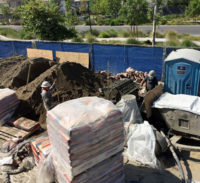
The SMA has items 1 and 3 covered for SMA contractor members. As a part of the SMA’s Silica Compliance Program, you will have a written plan tailored to stucco and adhered masonry work. This includes mixing mortar. The SMA has continually been monitoring silica exposure, and you are using “Industry Objective Data” as your monitoring requirements.
The SMA now offers Competent Person training to all members online, at no charge. Contact the SMA if you are interested in having a class. The SMA is also working on new and improved engineering controls for silica exposure through our continued monitoring efforts. [Click here if you need additional information about the SMA’s Silica Compliance Program.]
PROMOTING STUCCO
The SMA has been busy with architectural presentations and even visited a few large general contractors around the country to promote stucco. We are working jointly with our labor friends to promote stucco. The SMA budget for promotion is small, so more members mean more budget and more promotion. Help bring others in to help the stucco market grow. After all, cement plaster/stucco is a low maintenance, durable and cost effective cladding for the life cycle of a building.
SAVE THE DATE: SMA GOLF SEPTEMBER 24, 2018

The SMA’s annual golf tournament will again take place at the private Yorba Linda Country Club. It is always a well-attended event, and sponsorships are available in Gold, Silver and Bronze levels. Your sponsorship provides name recognition for your company and helps the SMA grow to promote a stronger stucco market. Online sign-ups coming soon.
Feature Articles
PERFORMANCE GRADE, PERFORMANCE CLASS AND DESIGN PRESSURE
The SMA recently presented a short class on Windows and Water Testing. While you might think “what is it and why should I care,” you might want to give it some thought. Evidence of this is when a few attendees came up after the class and express interest. This is because they are currently in a litigation case and watching water testing being applied to their stucco projects. A real-life example was presented where a national building envelope firm had designed and then tested for leaks. Most plastering contractors have no idea of the rules and protocols to water penetration testing. The SMA example clearly demonstrated the firm was not following proper protocols and procedures. The first and most clear evidence was the building envelope firm self-performed the water testing. The American Architectural Manufacturers Association is very clear that testing is only valid when done by an AAMA lab. They are true third-party, trained and use calibrated equipment. The rules can be complex — some experts may be testing fairly or they may be interpreting, tweaking or even making up the rules to fit a desired out come. If you play a sport, you know it helps to know the rules. Why would it be any different for water testing and your business? Knowing the rules can save you a lot of money.
WHY WATER? The experts will almost always drift to water testing. The more seasoned and experienced at litigation, the more they push for water testing. If you misplace a fastener and technically violate the code, the ultimate question is, will it cause damage? If you have damage, your insurance must pay. Water causes damage, even a tiny, slow and continual leak will cause damage. Is there anything you can do to protect yourself early on? While no one can guarantee you will not get sued, some knowledge and protective action can help protect you, your builder and the architect to better buildings and save everyone a lot of grief down the road. This is needed because unjust litigation does occur.
DESIGNERS: Plastering contractors are not designers and are advised not to take on that role. However, you can and should ask the designer for clarification and can even provide them information to better protect yourself and them. Handled properly, an architect will be grateful for the help. Architects have a daunting task: they must design to meet code, select products and assemblies that are appropriate, sustainable and stay within budgets. They cover electrical, plumbing, fire, sound, concrete, structural issues and a plethora of other design issues. They cannot be expected to be experts at every single discipline to design and construct a structure. It is just not possible in today’s complex world. They also have liability issues that can be significant, with repercussions that could result in a loss of their license, effectively putting them out of business.
COMPONENTS & CLADDINGS: A building is a mass of puzzles, pieces, codes and standards. Compliance is daunting to say the least. Most issues on building for the specialty contractor are very limited to their scope. But the specialty contractor should be an expert at his trade and have a working knowledge of all items that touch his/her trade. Architects must deal with the Components and Claddings section in the code. This requires architects to design a structure to meet established Design Pressures per a formula in the code. This is typically established by the Engineer of Record as a positive and negative wind pressure as it relates to stucco and windows. Since windows touch stucco and seem to have leak issues, it might help to know just a bit about windows and water testing. The architect is supposed to select windows, doors, decks and anything that interrupts the cladding based on this pressure. That is why what window works in Phoenix, Arizona, may have no relation to what is required in Miami, Florida. The cladding itself must be approved and how it is fastened to the structure to meet these criteria.
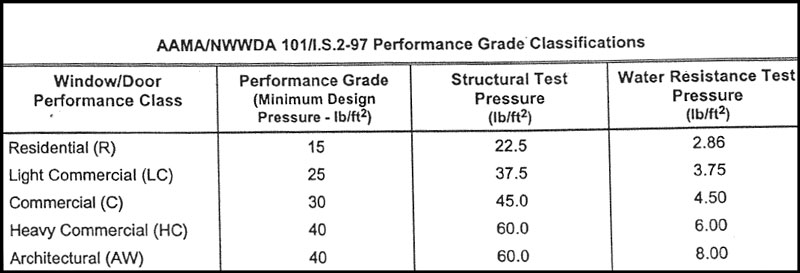
Fortunately, generic stucco claddings meet requirements, other proprietary claddings must have an Evaluation Report. Windows are tested rated in performance classes from Residential (R) to Architectural (AW) grade. Some architects are not well versed at design pressures and performance grades and fail to specify products suitable to the structure. Some developers will switch out products to save money by using a lower-rated product. In addition, different areas of the building can have different pressures, and windows can be put in the wrong place. The end result is that windows not rated for the location will leak, and too often stucco gets blamed.
It is not a bad idea to ask the general contractor if the window’s performance grade meets or exceeds the structural engineer’s wind loading to insure proper flashing and integrating the windows and your stucco siding. This is simple and does not make you a designer, but can alert the architect and general that we all need to be vigilant. The chart above, labeled AAMA/NWWDA 101/I.S.2-97, helps explain grades and pressures and illustrates not all windows are created equal.
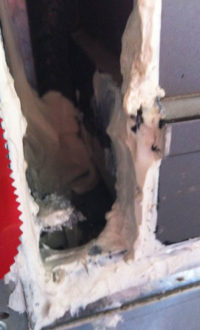
PASSED THEN FAIL: Another common issue is to have a design and construction team build and test with extreme water pressure on site. This gives everyone a sense of security that they will not get sued later. Then eight years later, the contractors are informed they are being sued for water leaks in and around windows in the stucco. How can that be? We tested at even higher pressures, they passed, but now leak?
The clue is that oftentimes you hear, “we never passed the first water test. But we work until it passes.” This can mean that blobs of sealant are continually added at leak points during the test until it passes the next test. The problem is that eight years later, those blobs have failed and water can now get in even under low pressure. The sense of security can disappear fast. The inset picture is one of those examples. The envelope firm on this project is nationally known and highly respected, yet the flashing was complex, poorly designed and simply not constructible. Water intrusion was obvious on the first few tests. However, with enough sealant smeared at just the right place(s), water is kept out, at least for now.
STUCCO AND CORNERS
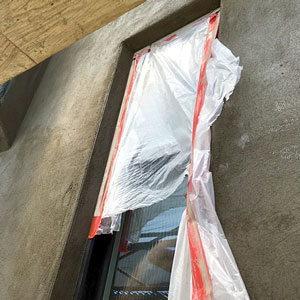
This may be one of the most important items a plastering contractor can read. You must match your corner trim accessory to the finish coat and the environment you are working on. The SMA routinely receives calls on corner issues and stucco. The most common is the rusty corner. The picture of the inset window in the cement brown coat is typical. One can see the nose of the corner aid vertically along the left side of the window. This is common and by itself not an issue. The aid is galvanized and will resist rusting. ASTM notes the aid shall be covered by 1/8 inch cement, traditionally accomplished by the addition of the cement finish coat. Compliance met and it works. However, acrylic finish coats have become very popular. They hold color better, they offer some flexibility and look great.
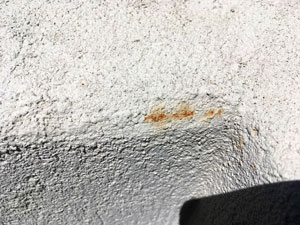
However, they can hold moisture in longer than then 1/8 inch of cement. In wet or very humid conditions, rust spots can occur on the corners when a galvanized nose aid or bead is in contact with acrylic or elastomeric coating. The solution is to use PVC nose corners when using an acrylic finish coat where the structure is going to be exposed to constant humidity. This is why PVC nose is popular in Florida and Seattle.
Another option often discussed is to bury the nose of the aid/bead in 1/8 inch cement brown coat. This makes little sense. The corner trim is a guide for the plasterer to use. The nose will naturally be exposed by the rodding of the brown coat to insure a flat and true plane. To add brown coat back will defeat the purpose of the procedure to rod the wall in the first place. The answer is to use a PVC nose on acrylic finish coats over cement plaster. I am certain many plasterers can swear they use metal nose all the time with acrylic finish and never have an issue. That is likely because the corner is not in a humid environment.
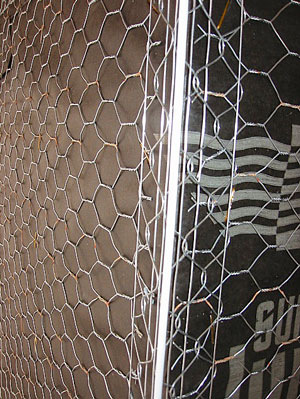
PVC NOSE: Some contractors in humid regions feel that using PVC nose 100% of the time on all projects is the solution to all their problems. That would seem to make sense, except there is a catch and a whole new problem arises when a cement finish coat is selected. The PVC nose will allow the cement finish to stick. However, over time the cement will pop off. The PVC will expand and contract, but cement will not. The PVC corner can flex, but the cement cannot. Acrylic finish expands and contracts with the PVC and flexes when it moves through structural deflection or impact.
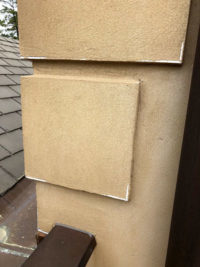
The plastering contractor is considered by the legal system to be the expert at his/her craft. Even if the architect specifies the wrong nose for the finish or the project, responsibility will generally fall onto the specialty contractor’s area of expertise and the failure to notify the designers of well-known practices by the industry. The following is recommended by the SMA.
- Use galvanized metal nose for cement finish coat stucco.
- Use PVC nose for acrylic finish coats over cement brown coats in regions with high humidity.
- Notify the architect or owner you prefer to follow SMA recommendations. Proceed as directed by design team or owner.
PLEASE NOTE: SMA OFFICE CONTACT INFORMATION
Mark Fowler, Executive Director
Marlene Lampert, Office Manager
Stucco Manufacturers Association
5753 E Santa Ana Cyn Rd, Suite G-156
Anaheim, CA 92807
Office: 213 379 5890
Mark@stuccomfgassoc.com
Marlene@stuccomfgassoc.com
REMEMBER: The SMA has a fairly large library on all things stucco. Members of the SMA are encouraged to call the SMA office if the staff can be of any assistance.
Winter/Spring 2018 eNews
MESSAGE FROM THE SMA EXECUTIVE DIRECTOR

Mark Fowler, SMA Executive Director
I would like to welcome all our new contractor members to the Stucco Manufacturers Association. The SMA Silica Compliance Program has dramatically increased the size of the SMA. This should help the plastering industry. A larger organization means better funding and opportunities to help the plastering industry. The result will be more influence to help designers with the correct selection for exterior siding — which is stucco. Helping the plastering industry helps all of us: whether you are a contractor, supplier or manufacturer, more marketshare means more work for you. An appropriate quote to consider is “a rising tide floats all boats.” For you new members, here is some useful information about the SMA.
Who is the SMA? The Stucco Manufacturers Association was incorporated in 1957 by the various cement stucco manufacturers in the California market. Over the years, the expansion has slowly grown to include the entire United States. The SMA holds quarterly meetings for networking and educational purposes.
Education: The SMA is a not-for-profit educational body and recognized by the design community as the authority on plaster and stucco. Our AIA online class is viewed several times a day by architects from all over the United States. The SMA helps designers with details and specifications on the proper use of cement stucco. The board of directors are keenly aware that some education and training for installers are also needed.
Promotion: I believe education is a form of promotion. If a cladding works because of education and training, it will flourish. Conversely, if a cladding has repeated failures, all the promotional ads in the world cannot help it. We know stucco works, in all climates. The SMA is working on a plan to boost the promotional efforts of stucco in commercial and residential markets. The resources of new members joining the SMA greatly help in that effort.
If you are an SMA member, your livelihood relies on stucco marketshare. Make no mistake — other claddings would love to see stucco lose its hold on the markets where we are strong. The benefits and long track record of stucco make it hard to convince people that stucco is not a good cladding. However, we should not sit by and let chance dictate our future. Stucco has a great future: whether it is three-coat, one-coat, EIFS or cement board systems, there is a system that is right for everyone out there, and we need to work harder and smarter at stucco promotion.
SILICA TRAINING
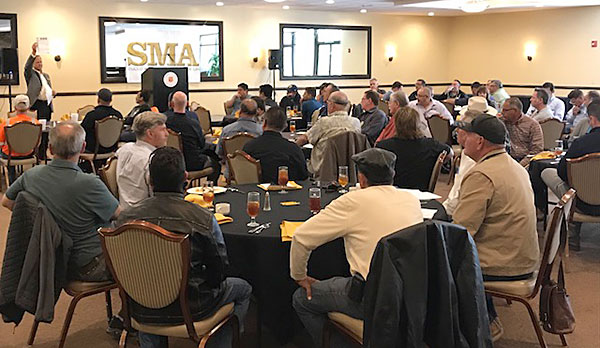
The first SMA Silica Compliance Training was held and the plaster industry now has 40 card-carrying “Competent Persons” on silica exposure for plastering and adhered masonry. While not every attendee passed the tough written exam, most did very well. The SMA Director was pleased as this was one of the biggest turnouts the SMA had in years. Large and small plastering contractors filled the room, even the OPCMIA made the class. Fowler commented this is important as every employer is required to have a written exposure plan and assign a competent person. This person should be trained at the tasks routinely performed that may put employees at risk of silica exposure. This training will help make workers safer and better the industry as a whole.
The SMA is already scheduled to hold classes in Fresno, Sacramento, Las Vegas, Austin, San Diego and Phoenix. Contact the SMA if you are interested in Silica “Competent Person” training.
Feature Articles
WHY I HATE ONE COAT!
Cement stucco has traditionally been a three-coat system. One-coat is really a two-coat system and merely reduces the basecoat thickness from a 3/4 to 7/8 inch thickness down to a 3/8 to 1/2 inch thickness. One-coat has been around for over forty years and many contractors resist it. The objections are varied from using unfamiliar trims to slight nuances in application. It seems contractors love or hate one-coat.
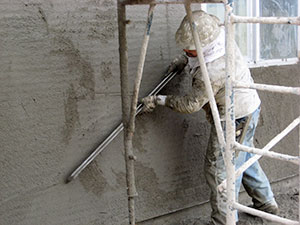
If you are a contractor who hates one-coat, you may want to ask yourself if you get tired of builders, owners or consultants stepping in to tell you how to lath and plaster when they have no idea about the practice. Three-coat stucco is generic with no manufacturer from start to finish. This opens the world interpretation to any and all. This can be the consultant who has never seen stucco or a homeowner who saw something on television and knows you are getting to them.
This is when a one-coat manufacturer can really help. One-coat is a system, the manufacturer is the king of the system and can be of great help when you need an educated and reasonable clarification to a situation. Consider how many times you have read project specifications that stated to install per manufacturer’s recommendations as opposed to install per contractor’s recommendations. This is a tool many contractors fail to use. Most manufacturers are very adept at how their systems work. They can be a great assistance if you know how to use them. This does not mean trying to get them to cover mistakes or improper workmanship, but does mean they can be flexible to work with you as a partner to insure the owner gets a stucco job that works without spending money on pointless or redundant extras.
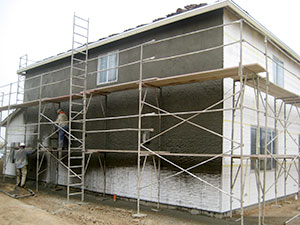
Another thought on one-coat is the litigation angle. If you get caught in a case where a lawyer points out that your control joint layout or installation is not per ASTM, you have a hard fight ahead with three-coat stucco. However, with one-coat stucco, you have two quick answers.
- The ASTM covers three-coat, not one-coat, so it is not the correct standard to reference.
- The approval for one-coat is by the code on “alternative materials and methods”; you need to refer to the evaluation report and then the manufacturer for allowable variations to their system.
The other issue that should make you think is the Continuous Insulation craze. One-coat is the only hard coat cement stucco fully code compliant, tested and proven for a cement stucco over a rigid foam. While three-coat cement plaster over rigid foam works, back-up from authoritative sources can be challenging. Not the case with one-coat stucco — it was born over rigid foam sheathing. If you hate one-coat stucco, you may want to re-think it.
TEN THINGS EVERY STUCCO CONTRACTOR NEEDS TO KNOW
-

Flashing is critical to ensure stucco will work. Flashing: Flashing is important on all claddings, but more so on cement stucco over framed walls. This is because stucco does a great job keeping bulk water out. Conversely, stucco also holds bulk water in. This means bulk water that gets behind the stucco has only a few options. Some will be absorbed and then diffuse as a vapor to the outside, but this is a slow process and water can flow down and must be directed out. Flashing is more critical for stucco and, when done correctly to minimize water enter and direct water out, stucco is the best cladding you can select. Failing to provide flashing can trap water and cause rot and decay, faster than with other claddings.
- Cracking: Cracking is inevitable with a brittle cement cladding. Hairline cracks are not a point of water entry. Even the Romans knew concrete was great for transporting water. The hairline cracks would virtually self-seal on the inside. This should not be used as an excuse for excessive or large cracks. However, crack free stucco is unrealistic and not required for stucco to work.
- Control Joints: The code and ASTM have requirements for placement and installation of control joints in stucco. Building owners should be notified of the requirements and then allowed to decide if they want to exercise provisions of the code that allow for alternatives. This should not be your decision. You should also be fairly compensated if they require more than the plans illustrate.
-
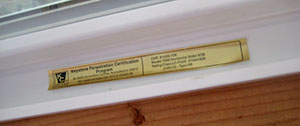
Gold sticker on the window lists Performance Grade for this product. Windows: You should know all windows are NOT created equal. They get a Performance Grade from the manufacturer. Using a window under rate will leak, regardless of how great you flash it. While this may not be your problem, you will be dragged in and forced to defend yourself. It is easier to get confirmation upfront that the windows are properly rated for the project.
- Concrete Masonry Units: Stucco over CMU is time honored and proven. Yet many want to add a building wrap or paper to add extra water protection. This is generally a bad idea. Stucco should bond to the CMU. A slip sheet can create cracking and even reduce water resistance. Attaching the wrap to CMU will punch holes in the product that will not seal the same framing members.
-
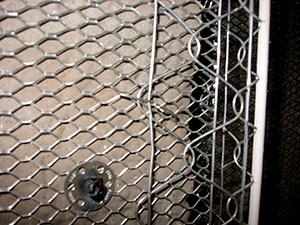
Plastic nose corner for stucco to receive an acrylic finish coat. Know Your Corners: Corner beads and aids have plastic or steel noses. Stucco finish is cement or acrylic. Cement will want to flake off of plastic nose beads, where acrylics can rust metal noses in damp areas. Pick the nose to match the finish coat.
- Records: Keep records on when you did what. One of the first things consultants think when cracking starts (see item #2) is that you did not allow a cure time. Wait seven days minimum before applying any finish coat to your basecoat. If the builder wants you to accelerate the time, send him a letter that this “may” result in more hairline cracks in the long run. Protect yourself.
- Know ASTM: ASTM has been around a long time. The code used to describe how to install stucco, but they now opt to reference ASTM standards, and these standards are changing. You are required to follow ASTM. You can get relief on many items if you know the rules (see item #3), but you have to know what ASTM is telling you. Get a copy.
- Pre-Installation: You must walk the site and look over every possible item that could impact your stucco and its performance. Turn off your cell phone, take notes and pictures (see item # 7). Insist on a pre-install meeting with the GC, architect and owner to review expectations and concerns from all sides. Do not send threatening CYA letters, but express concern on what “might” happen. These are powerful tools, and even ones worded in a non-threatening tone can have your insurance carrier almost hugging you.
- You Don’t Know What You Don’t Know: This goes for everyone onsite. Most architects do not really understand stucco, so cut them a break. Help guide them to resources they will trust rather than try to prove you know more about stucco than they do. Because you do not know what they know, which is a lot about engineering, building science and the code. Remember you and they do not know everything.
PAINTING STUCCO
The SMA receives dozens of calls from stucco homeowners who express concerns about painting stucco and fear it will be a nightmare. This is likely the result of the prominent home improvement scam that hit the industry in the fifties and sixties. These were quick fixes to cure all siding maintenance and sounded to good to be true, because it was. This was the textured coatings boom that promised to forever eliminate painting and maintenance on your home. Even the commercials on television and radio had thrilled homeowners talking about a textured coating applied to their stucco home. The promise to eliminate the cracks and the need to ever paint again was very appealing. Seeing these textured coated homes was a bit shocking for plasterers. They sprayed the stucco, the eaves, the electrical box and the family dog if they could. They kept the masking to a bare minimum. Once done, your options to fix the nightmare were limited to strip and re-stucco. It was an expensive proposition. The hoodwinked homeowner learned a painful and expensive lesson. I suspect they told neighbors and the word got around. The craze eventually died out.
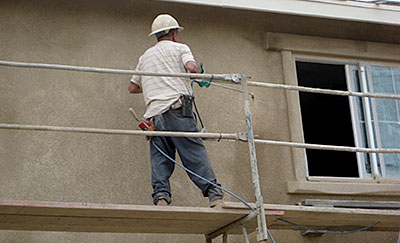
A few decades have passed and now it seems people are terrified to simply paint on stucco. Painting stucco is fine. Success depends largely on what you expect and what products are selected to paint with. Generally, paint will not cover cracking in the long term. While elastomeric coatings can hide the cracks, they can also have issues of vapor permeability. Stucco over framed walls works better if they allow moisture to escape. Sealing moisture out can have the reverse effect too, sealing it in.
Acrylic paints made specifically for stucco work well and are proven to last a long time. These products can breathe and do not trap moisture vapor in the walls. Painting new stucco is also acceptable. The pH level on newly applied stucco can be high and should be allowed to drop to 8 before painting. If an elastomeric is desired, products with a perm rating of 7 or higher are advised, and the stucco wall should be inspected by an expert in stucco to insure it is compatible for this coating. Using an elastomeric to solve water intrusion issues is a low-cost fix and generally does not fix the issue.
Fog coating is a cement-based paint. Fog coat is low cost and used only for cement finish coat stucco that is free of paint or coatings. It is a product designed to even out color inconsistencies that are inherent with cement stucco finish coats. Using fog coat to change the color of a stucco is possible and, while it can be done, painting is generally better. Finding an expert at fog coating can be challenging, and it is typically better to paint the stucco with a quality acrylic made specifically for stucco.
REMEMBER: The SMA has a fairly large library on all things stucco. Members of the SMA are encouraged to call the SMA if the staff can be of any assistance.
PLEASE NOTE: SMA OFFICE CONTACT INFORMATION
Mark Fowler, Executive Director
Marlene Lampert, Office Manager
Stucco Manufacturers Association
5753 E Santa Ana Cyn Rd, Suite G-156
Anaheim, CA 92807
Office: 213 379 5890
Mark@stuccomfgassoc.com
Marlene@stuccomfgassoc.com
Fall 2017 eNews
MESSAGE FROM THE SMA EXECUTIVE DIRECTOR

Mark Fowler, SMA Executive Director
The new OSHA Silica Exposure standard is here, and soft enforcement has begun. OSHA will be looking, and good faith efforts to comply with the new standards will be required. Being enrolled in the SMA Compliance Program is a good start. The construction industry had a PEL of 250 micrograms per cubic meter of air as an 8 hour-Time Weighted Average (TWA). The new PEL has been reduced to 50. This is a significant reduction, and OSHA states it will save thousands of lives by reducing the fatal illness known as silicosis. For information about the required written exposure plan, competent person and other requirements, refer to the SMA Silica Compliance Program [click here]. The SMA has done industry testing and prepared a plan for plastering and stucco work. There will be more upcoming tests and updated Exposure Control Plan. Being in the SMA program will keep you informed of changes.
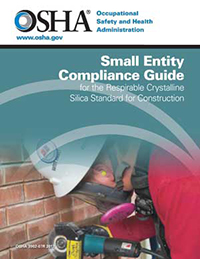 ASBESTOS: The plaster industry has raised concerns that this is likely the next ‘asbestos’ issue. While similarities exist, there are also significant differences. Unlike asbestos, silica is one of the most common materials found on earth. Banning silica is not feasible. Unlike asbestos, the OSHA standard known as 1926.1153 sets protocols for compliance, not a ban of the product. Adhering to these work rules will better protect employees and keep employers in compliance. To learn what you need to know, the SMA has a link [click the cover image at right] to the OSHA “Small Entity Compliance Guide.” This guide is the explanation to the ruling, compliance and allowable paths to compliance.
ASBESTOS: The plaster industry has raised concerns that this is likely the next ‘asbestos’ issue. While similarities exist, there are also significant differences. Unlike asbestos, silica is one of the most common materials found on earth. Banning silica is not feasible. Unlike asbestos, the OSHA standard known as 1926.1153 sets protocols for compliance, not a ban of the product. Adhering to these work rules will better protect employees and keep employers in compliance. To learn what you need to know, the SMA has a link [click the cover image at right] to the OSHA “Small Entity Compliance Guide.” This guide is the explanation to the ruling, compliance and allowable paths to compliance.
FALL WEATHER: Fall is here and cold weather is just around the corner. While cooler weather can increase production rates and lessen the need for damp curing of cement plaster, it also can mean workers need to start covering materials and thinking about rain, frost and even snow fall. Shocking to most plasterers in the southwest, cement stucco is done in cold climates and winter protection is an annual concern. Minnesota and Alaska both use stucco with regularity, and stucco has performed well for decades. Russia and Germany rely on stucco to clad most of their buildings. After all, what other cladding material actually gains strength over time?
STUCCO & FIRE: The recent fires in California also point to another major benefit of stucco. The cement membrane is noncombustible and provides superior fire protection for homes. Historical studies have clearly shown cement stucco outperforms other claddings for fire protection, durability, design flexibility and economy.
STUCCO PROMOTION: The SMA is working on a plan for greater promotion of cement stucco. Other claddings with far less qualities than stucco are taking market share. Do not believe that designers do not like plaster or that stucco is not suitable for their projects. It is about promotion. We need to promote to designers and not to ourselves. Other claddings have large budgets and work hard to develop well thought-out and executed marketing campaigns to promote their claddings to architects. It is time for stucco to do the same. We need to develop a marketing plan for stucco. We need to reach out to designers and developers and have them take a second look at stucco. Since stucco is primarily a site blended and generic product, it must be the contractors that help push the need if they want to insure future market share. Market share will not increase without a concerted and purposeful effort. Other industries do this, but plastering promotion to designers has been seriously lacking for decades. The significant increase in stucco contractors signing up to the SMA due to the Silica Exposure Control Plan could provide the funding needed to develop such a plan. The SMA welcomes all the new plastering contractors and hope they join us in the pledge to work on plans to increasing stucco market share.
SMA GOES TO TEXAS!
The SMA will be presenting a stucco class to a group of Texas developers on November 1 in Austin, Texas. The program will be to educate developers on stucco and promote greater use of cement plaster stucco on projects. This is the first SMA program in Texas, and we have others planned in other states. The SMA is the national voice for plastering, and growth of the SMA equals growth for plastering and stucco market share. The in-person presentation complements our on-line AIA classes that are already taken by architects from around the United States. Supporting the SMA supports your business growth in enhanced market share.
SMA GOLF 2017

The 2017 golf tournament was the biggest ever. The private Yorba Linda Country Club was appreciated by the SMA membership, and we will be returning next year. Our raffle was filled with great prizes thanks to our sponsors.
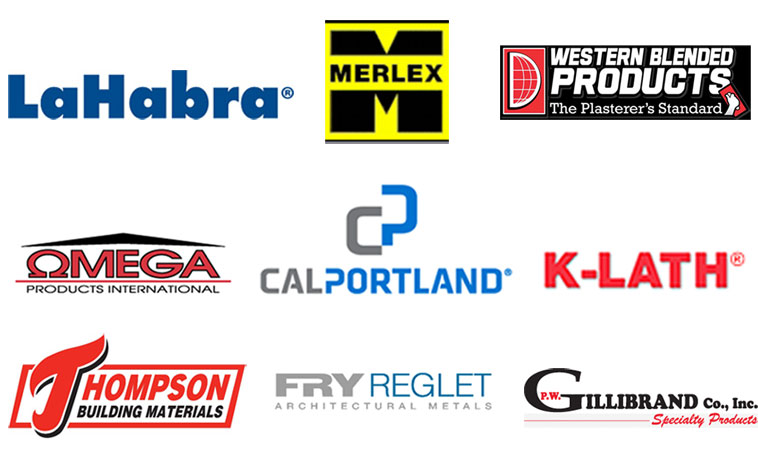
SIGN UP NOW: NEXT SMA MEETING ON NOVEMBER 8

Chris Thornberg is BACK! SMA members have enjoyed Dr. Thornburg’s witty and entertaining presentations on the economy. For those who may not know, Chris predicted the crash of 2008 before most had a clue trouble was on the horizon. What he predicts now about the economy and the housing/building crisis could be helpful to you and your business. The meeting is set for November 8 at the Yorba Linda Country Club. Plan to attend — a sellout is expected. Click here to sign up online now.
Feature Articles
What Is the SMA?
If you are new to the SMA, welcome — and let us tell you about us. The SMA is a national not-for-profit industry trade association formed in 1957 to improve stucco, enhance products and educate the industry. We do this through collaboration of manufacturers, dealers, contractors and industry consultants. We produce technical papers, provide assistance to designers and contractors on all issues related to plastering/stucco. Unlike many other groups, we are not conflicted by supporting other cladding or materials that take work away for the lath and plastering contractor. We also have networking events and — with new contractors signing up from around the United States — it is hopeful we will soon be able to hold regional meetings in other areas of the United States. The SMA has committees to focus on specific issues and improve stucco. Our goal is to educate and help contractors be successful and profitable. We know contracting in lath and plaster is a tough business; we can help. Working together we can make a difference on the future of stucco. Members can use the SMA or L&P logo on business cards, stationary or promotional items. Contact Marlene Lampert at the SMA office for more information.
SMA’s Plaster Troubleshooting Guide
Our plaster troubleshooting table was first published in 1965 by the SMA and has been recently updated. The SMA offers this as a general troubleshooting guide of problems or unwanted conditions found or related to portland cement plaster/stucco walls. The chart lists the conditions, possible causes, preventions or possible remedies. Not all of these conditions are in the control of the plastering contractor. This chart [click image at right] can also be used as a pre-installation discussion guide for plaster/stucco projects to help avoid unwanted conditions.
WEEP SCREED, HISTORY AND THE CODE
Building Codes require a weep screed at the base of stucco framed walls along the foundation plate line. The weep screed was introduced into the code in 1970 and, over the years, more clarifications were added.
- Placed at foundation plate line and allow trapped water to drain to the exterior (introduced in 1970 Code)
- To be made from 26 gauge galvanized steel or approved corrosion resistant material (introduced in 1985)
- Have a 3 ½ inch high attachment flange (introduced in 1985)
- The nose is to be 4 inches off of the raw earth ( introduced in 1979)
- The nose is to be 2 inches off of paved services (introduced in 1991)
- The bottom of the weep screed is to be 1 inch below the framing/concrete transition (ASTM 2001)
- The weather- (water-) resistant barrier and lath shall lap the attachment flange (introduced in 1979)
Alternates to code required weep screed are allowed if approved by the Building Official. It is the responsibility of the designer/user to verify the detail is appropriate for the climate and location on the building. The SMA has details providing options, with permission from the local building official prior to usage. Most building departments have accepted the SMA alternates. Contact Mark Fowler at the SMA if you need assistance.
PLEASE NOTE: SMA OFFICE CONTACT INFORMATION
Mark Fowler, Executive Director
Marlene Lampert, Office Manager
Stucco Manufacturers Association
5753 E Santa Ana Cyn Rd, Suite G-156
Anaheim, CA 92807
Office: 213 379 5890
Mark@stuccomfgassoc.com
Marlene@stuccomfgassoc.com


